User Guide
ChopChop

Table of Contents
- 1 Introduction
- 2 Quick Start
- 3 Overview
- 4 Navigating the User Interface
-
5 Commands
- 5.1 Command Syntax
- 5.2 Tab Completion
- 5.3 General Commands
- 5.4 Recipe Commands
- 5.5 Ingredient Commands
-
5.6 Statistics Commands
- 5.6.1 Listing Top Recipes —
statsrecipe top - 5.6.2 Listing Recent Recipes —
statsrecipe recent - 5.6.3 Listing Recipes within a Time Frame —
statsrecipe made - 5.6.4 Clearing Recipe History —
statsrecipe clear - 5.6.5 Listing Recent Ingredients —
statsingredient recent - 5.6.6 Listing Ingredients within a Time Frame —
statsingredient used - 5.6.7 Clearing Ingredient History —
statsingredient clear
- 5.6.1 Listing Top Recipes —
- 5.7 Command Summary
- 6 Quantities and Units
- 7 Frequently Asked Questions
- 8 Glossary
1 Introduction
ChopChop is a food recipe management system, which aims to help users manage their recipes and ingredients in an easy and effective manner. It is a desktop app, optimised for use through typing textual commands; for fast typists, ChopChop will be able to manage your recipes more efficiently than other applications. Even so, it also features a graphical user interface (GUI) to display ingredients and recipes in an interactive manner.
Furthermore, our command interface also features tab completion, which will greatly increase the speed at which you can use ChopChop by reducing the amount of typing required.
1.1 Navigating this Document
This user guide provides an in-depth guide about how to use ChopChop; simply choose a topic from the Table of Contents above to find answers or get step-by-step instructions. In addition, the quick start guide provides an end-to-end setup process to help you get started with installing ChopChop.
Specifically, this document covers:
- The components of the user interface
- The syntax and behaviour of the commands
- Detailed usage examples, with step-by-step illustrated walkthroughs
- Other usage notes and features
1.2 Document Conventions
In this document, some elements are styled differently for emphasis. These include:
-
 — This indicates a useful piece of information that can make using ChopChop easier
— This indicates a useful piece of information that can make using ChopChop easier -
 — This indicates something that you should pay attention to
— This indicates something that you should pay attention to -
code— Text styled in this font generally indicates commands that you will type into the command box (see below) - enter — Text styled in this font indicates keys that you press on your keyboard
2 Quick Start
To start using and experimenting with ChopChop, here are the steps you can follow:
-
Ensure you have Java 11 or above installed in your computer; it can be obtained from AdoptOpenJDK.
-
Download the latest chopchop.jar from here.
-
Copy the file to the folder you want to use as the home folder for your ChopChop.
-
Double-click the file to start the app. The GUI similar to the below should appear in a few seconds. The app starts with some sample data for you to experiment with.
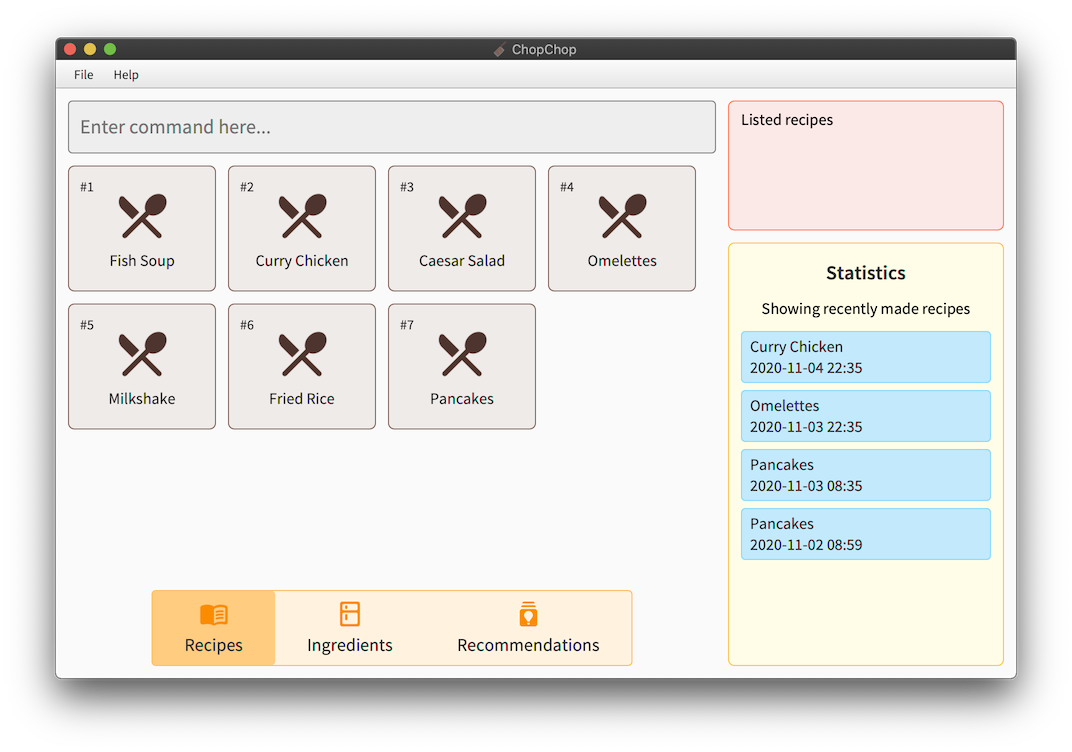
Figure 1.1: The initial state of ChopChop, including sample data
Now that you have ChopChop installed, you can start to play around with the sample data — add recipes, ingredients, and more! Some commands you could try include:
-
add ingredient milk /qty 500ml /expiry 2020-11-09— to add some milk -
add recipe milkshake /ingredient milk /qty 250ml /step Add milk /step Shake— to add a recipe
To exit ChopChop, you can either use the quit command, or simply close the application window.
3 Overview
ChopChop manages two key components — ingredients and recipes — and they will be the main pieces you will interact with. Common to both are names and tags, the latter of which allow you to quickly group related ingredients or recipes together, or to organise them in any way you desire.
Names and tags are both case insensitive, so pAnCaKeS and Pancakes refer to the same recipe. Note that you cannot have duplicate recipes nor ingredients in ChopChop; items are duplicates if their names are the same.
3.1 Recipes
A recipe consists of a list of ingredients and associated quantities used, as well as a list of ordered steps in textual form.
3.2 Ingredients
An ingredient consists of a quantity with an associated unit, and an optional expiry date. Each ingredient can have multiple sets, where each set is a given quantity of that ingredient, expiring on a certain date.
For example, you might have 500 mL of milk that you bought last week that expires tomorrow, while you have another 1.5 L of milk that you bought today, expiring two weeks from now. ChopChop will track both these sets, and will intelligently use the earliest-expiring set when doing its accounting.
For a more in-depth look at how ChopChop handles quantities, see this section.
3.3 Name Constraints
Recipe and ingredient names have the same constraints, of which there is only one — they cannot consist only of a # followed by digits, to diambiguate them from numbered references (for the tech savvy, the regular expression is #[0-9]+).
Here are some examples of names that are valid and invalid:
| name | valid |
|---|---|
#1 |
✘ |
#1234 |
✘ |
# |
✔ |
#asdf |
✔ |
#1a |
✔ |
#1 abc |
✔ |
#12 34 |
✔ |
4 Navigating the User Interface
ChopChop’s UI design allows users to view all of the information you need in three main tabs. However, that might lead to a slightly steeper learning curve. Hence, this section aims to give you a breakdown of the GUI’s various components.
Specifically, this section covers:
- Command Box
- Command Output
- Recipe Button
- Ingredient Button
- Recommendation Button
- Statistics Box
- Recipe Tile
- Ingredient Tile
- Recipe View
First, here is the overview of the components of the recipe list view in ChopChop, which you will be greeted with when first starting the application:
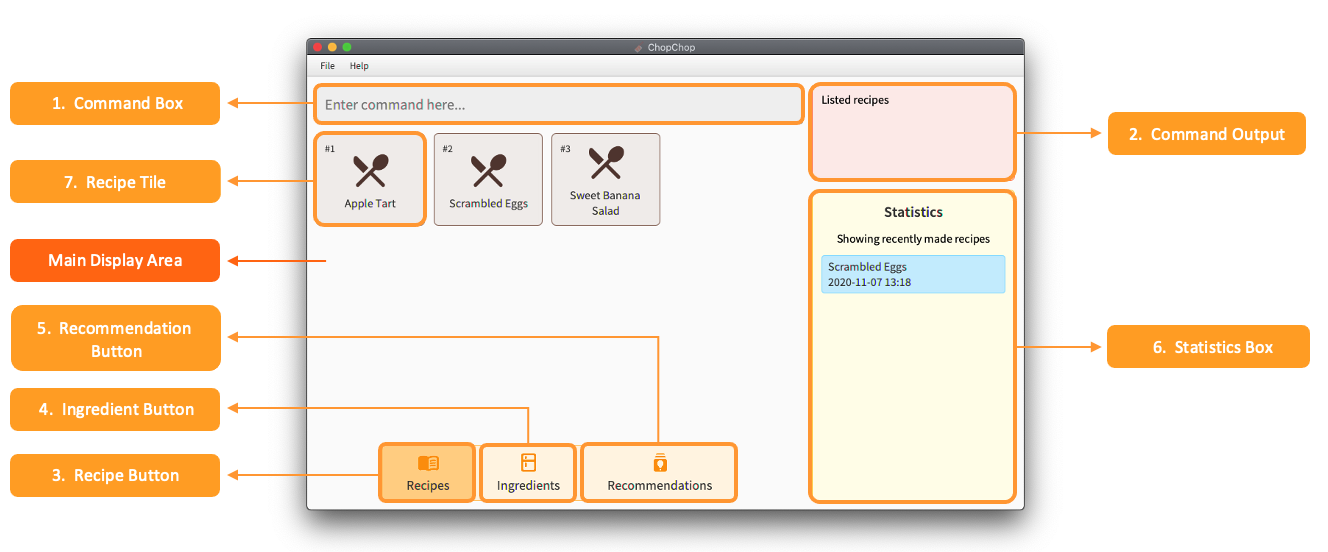
Figure 1.2: The Recipe List Panel of ChopChop.
4.1 Command Box
ChopChop does your bidding by listening to your commands — the Command Box is where you type your textual commands. After typing your commands, press enter to input the command. You can also use the up and down arrow keys to navigate through the history of commands you’ve typed previously.
To learn about the commands you can use, check out our command summary for a quick overview or our commands for a detailed list. You can also use tab completion to speed up typing commmands!
4.2 Command Output
ChopChop will always display textual responses to the commands you input — the Command Output is where you can view the responses.
4.3 Recipe Button
ChopChop is able to display all of your recipes as Recipe Tiles in the Main Display Area as shown in figure 1.2 when you press the Recipes button. The 4 buttons at the bottom of our GUI will take on a darker shade when they are currently selected.
4.4 Ingredient Button
ChopChop is able to display all of your ingredients as Ingredient Tiles in the Main Display Area as shown in figure 1.3 when you press the Ingredients button.
4.5 Recommendation Button
ChopChop is able to recommend you recipes to cook if you want it to! The recipes that are recommended will be displayed as Recipe Tiles in the Main Display Area when you press the Recommendations button.
4.6 Statistics Box
ChopChop is able to produce statistics based on the food you make! To view your ingredient or recipe usage statistics, simply input into the Command Box one of the stats commands available.
4.7 Recipe Tiles
ChopChop is able to show you your recipes in the form of tiles — simply click on a tile to view the detailed information about the selected recipe in the Main Display Area, as shown in figure 1.4.
4.8 Ingredient Tiles
ChopChop is able to show you your ingredients in the form of tiles, as shown in figure 1.3. In each tile, there are 5 components:
- The Index shows the index of the ingredient for easier referencing.
- The Expiry Date of the ingredient.
- The Quantity of the ingredient.
- The Ingredient Name of the ingredient.
- The Tags associated with the ingredient.
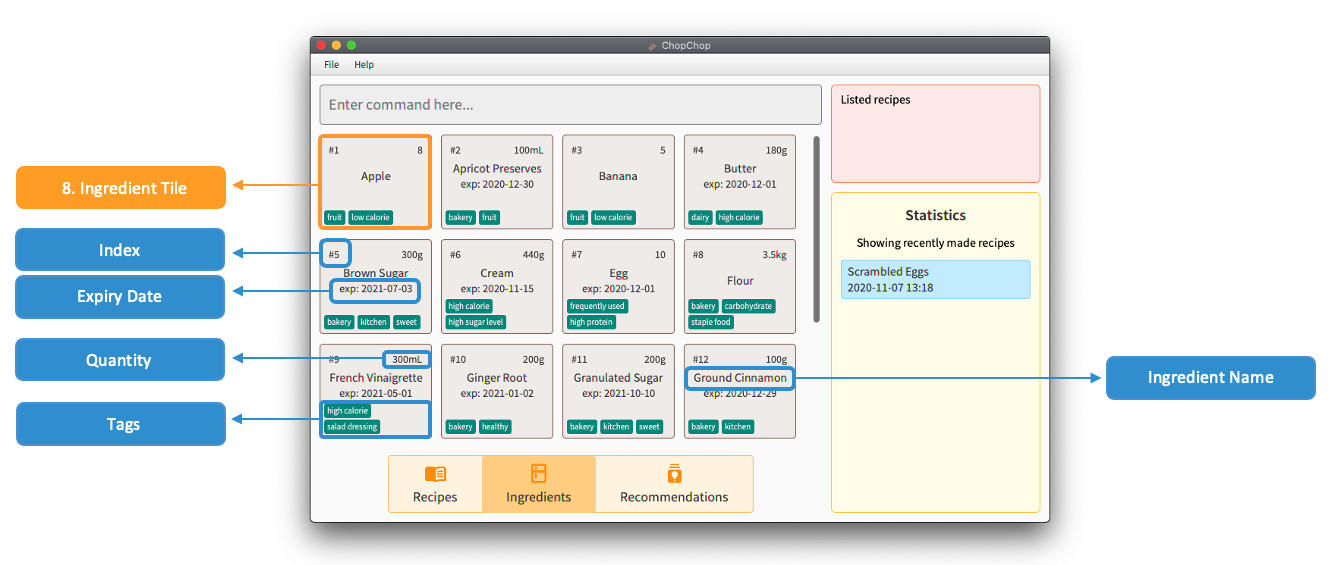
Figure 1.3: The Ingredient List Panel of ChopChop.
When showing the expiry date, ChopChop only displays the earliest expiry date out of all the ingredient sets that exist. For example, if you have 500 ml of milk expiring on the 11th of November and 1.5 l expiring on the 19th, the expiry date will be shown as the 11th.
Note: if the tags are too long, some graphical glitches might occur. This will be fixed in the next version!
4.9 Recipe View
When clicking on a recipe or view-ing it, ChopChop will show the full details of the recipe. In this view, you can see the entirety of the recipe:
- The Name of the recipe
- The Tags associated with the recipe
- The Ingredients used by the recipe (along with their quantities)
- The Steps involved in making the recipe
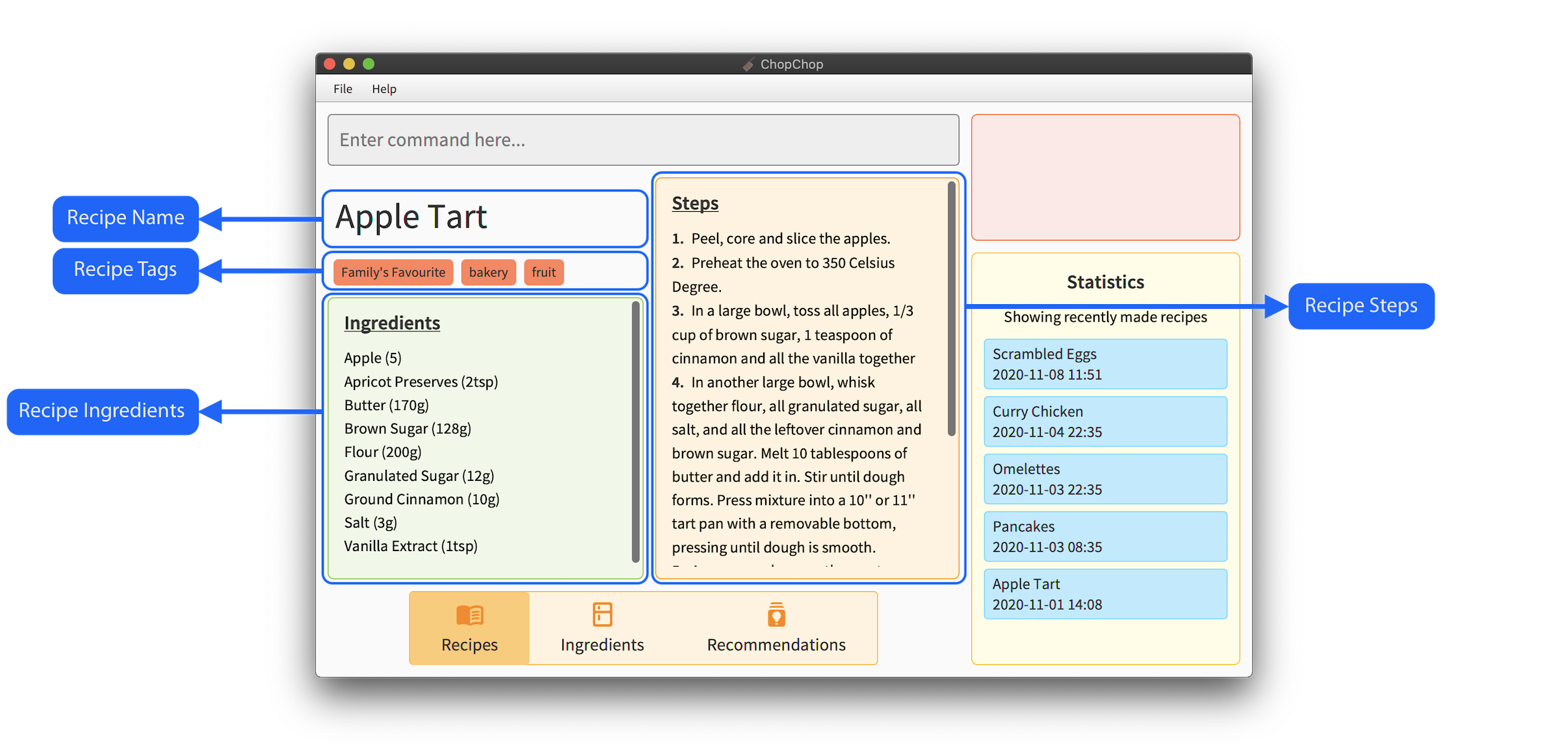
Figure 1.4: The Recipe View Panel of ChopChop.
5 Commands
While ChopChop has a graphical user interface, the main method of interaction is through the use of typed commands. Using these commands as described below, you can manipulate your recipes and ingredients without ever needing to move your mouse!
Commands should be typed in the Command Box — you can refer to figure 1.2 above if you get lost. ChopChop also features tab completion, which will make typing commands easier.
5.1 Command Syntax
To succinctly represent the syntax of the various commands, we adopt a simple notation in this User Guide, as shown below:
-
Words starting with a slash (
/) denote named parameters; these names are case sensitive (eg./STEPis not the same as/step). All the text following a named parameter belong to it, until either the end of the input, or the next named parameter.
Example: in/param1 lorem ipsum /param2 dolor sit amet, the parameter param1 will have the value “lorem ipsum”, while the parameter param2 will have the value “dolor sit amet”. -
Words in angle brackets (eg.
<name>) denote an input that is provided by you, the user.
Example: the add ingredient command is specified like this:add ingredient <name> /qty <quantity> [/expiry <expiry-date>]; in this case, you would need to provide the name, quantity, and expiry date. -
Portions in square brackets (eg.
[/expiry <expiry-date>]) denote optional parts of the command. In this example, not all ingredients will expire, so the expiry date is optional. -
Portions with trailing ellipses (eg.
[/step <step>]...) denote commands accepting one or more of the given parameter. In this example, a recipe can have multiple steps, so you can specify multiple/steparguments. -
A
<#REF>refers to an item reference, and is used to refer to either a recipe or an ingredient. It can either be the (case-insensitive) name of the item, or it can be a number prefixed with ‘#’.
Example:#3refers to the third item in the list, whileBest Pancakesrefers to the recipe named ‘Best Pancakes’. In the GUI, you can see the number of an item in the corner of Recipe Tiles and Ingredient Tiles. -
Generally, the order of arguments is important; for example, the order of
/stepdetermines the order of the steps in the recipe, while a/qtyin an add recipe command must only appear after an/ingredient.
5.1.1 Escaping Slashes
Since ChopChop uses / to denote argument names, it would seem that recipe and ingredient names cannot contain slashes. Worry not, because you can escape these slashes! This is done by prefixing the / with a backslash, eg. \/. For example, if you want to make a recipe named some / recipe, you would instead use some \/ recipe.
In other contexts, the backslash (\) behaves like a normal character and doesn’t do anything special.
When tab-completing names, ChopChop will automatically insert the backslashes for you, so that you don’t have to worry about it when typing your commands.
5.1.2 Date Formats
Across ChopChop, dates have the same format: yyyy-mm-dd. Examples include:
-
2020-11-09for the 9th of November, 2020 -
2021-02-28for the 28th of February, 2021
Note that each part (the year, month, and date) must always be 4, 2, and 2 digits respectively. For months and days, add a 0 to the beginning to make up 2 digits (eg. 04 for April).
5.2 Tab Completion
Suppose you wanted to add a recipe for pancakes, and you wanted real, industrial strength pancakes (unlike the simplified recipe we’ll be using below) — the list of ingredients would look something like this:
add recipe Pancakes
/ingredient flour /qty 290g
/ingredient egg /qty 1
/ingredient sugar /qty 60g
/ingredient baking powder /qty 4tsp
/ingredient baking soda /qty 0.25tsp
/ingredient salt /qty 3g
/ingredient milk /qty 440ml
/ingredient butter /qty 60g
/ingredient vanilla extract /qty 2tsp
/step ...
That certainly seems cumbersome to type out in full, so what if there was a way to speed it up drastically? You can, simply by pressing the tab key to let ChopChop “fill-in-the-blanks” for you!
5.2.1 Introduction to Tab Completion
Here’s what you can do instead (where tab represents pressing the tab key):
a tab r tab Pancakes /i tab f tab /q tab 290g /i tab e tab /q tab 1 /i tab su tab /q tab 60g /i tab baking p tab /q tab 4tsp /i tab baking s tab /q tab 0.25tsp /i tab sa tab /q tab 3g /i tab m tab /q tab 440ml /i tab bu tab /q tab 60g /i tab v tab /q tab 2tsp
At just 126 compared to 289 keystrokes, that’s more than a 50% reduction! ChopChop will intelligently fill in commands, parameter names (eg. /ingredient), recipe names, ingredient names, and tag names.
5.2.2 Using Tab Completion
How does it work? ChopChop uses the current text when completing and searches for the appropriate matching items; it knows to look for ingredient names while within an /ingredient parameter, and to look for ingredient tags instead of recipe tags when in an add ingredient command.
What if there are multiple items that share a prefix, for example baking powder and baking soda in the pancake recipe above? Worry not; pressing tab repeatedly will cycle through the available completions, and they are sorted lexicographically (length, followed by alphabetical order) — pressing tab after /ingredient b would give you butter, baking powder, and baking soda, in that order, before giving you butter again.
The same thing applies to commands; f tab would cycle between find and filter.
5.3 General Commands
These commands are general commands that do not operate on ingredients or recipes.
5.3.1 Getting Help — help
This command shows a message with a link to this user guide; you can use it to easily access this page from the application. The link can be clicked, and will open this page in your web browser.
Furthermore, you can also use this command to get help for specific commands. In that case, clicking the link will bring you to the corresponding section in the User Guide for that command.
Usage: help [<command-name> [<command-target>]]
Examples:
-
If you simply want a link to this page, you can use
help:
Figure 2.1: The help message, with a link to this User Guide -
If you want help for a specific command — for example, how to add recipes — you can use
help add recipe, which will give you a link that brings you to that specific section: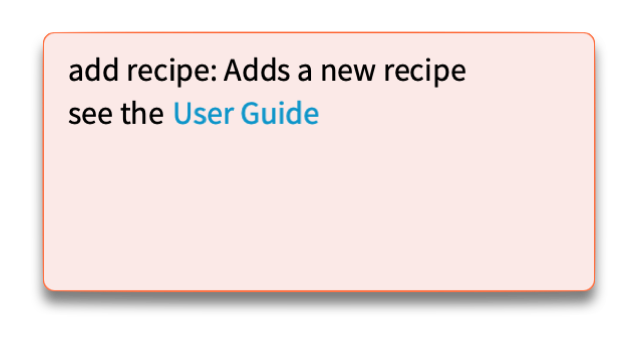
Figure 2.2: The help message for a specific command
5.3.2 Quitting ChopChop — quit
This command quits ChopChop. You can rest assured that your data is automatically saved whenever a command is executed, so you do not need to save it manually before quitting.
Usage: quit
5.3.3 Undoing Commands — undo
This command undoes the last undoable command. Undoable commands are commands that involve changes to recipes and ingredients stored in ChopChop. You can check the command summary for a quick list of which commands can be undone.
Usage: undo
The most common scenario to undo a command is when accidentally deleting something; for example, suppose you wanted to delete the Salted Water recipe, but you accidentally deleted the Scrambled Eggs recipe instead:
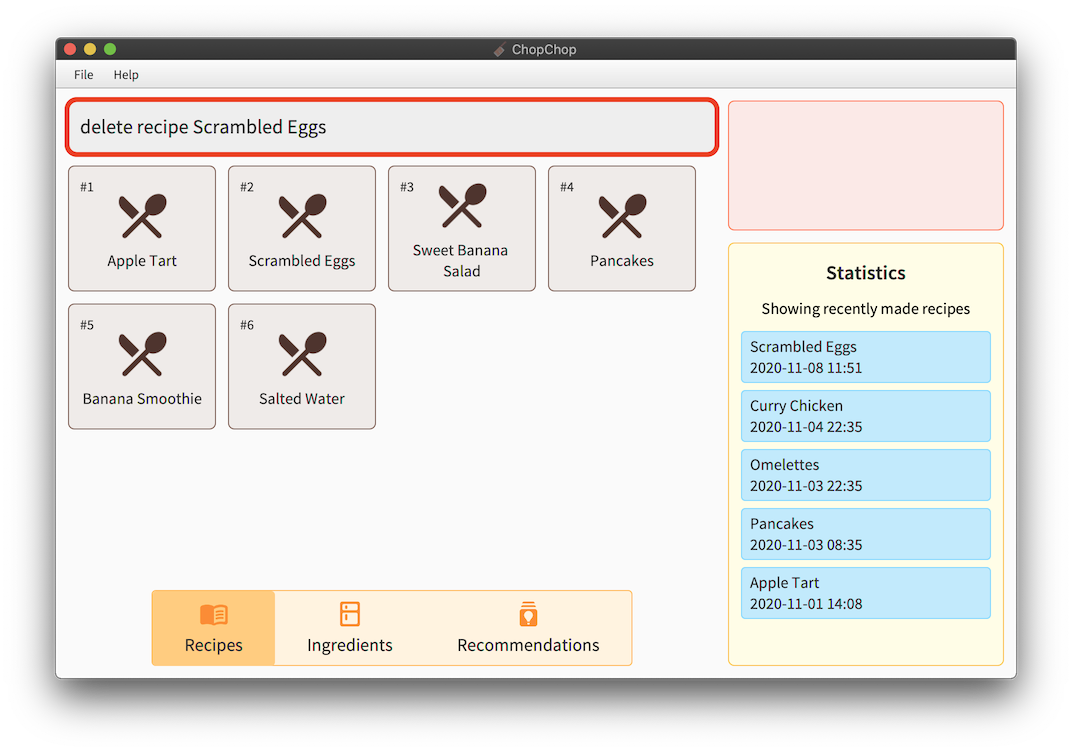
Figure 3.1: Accidentally typing 'Scrambled Eggs' instead of 'Salted Water'
Fear not, because fixing the mistake is a simple undo away:
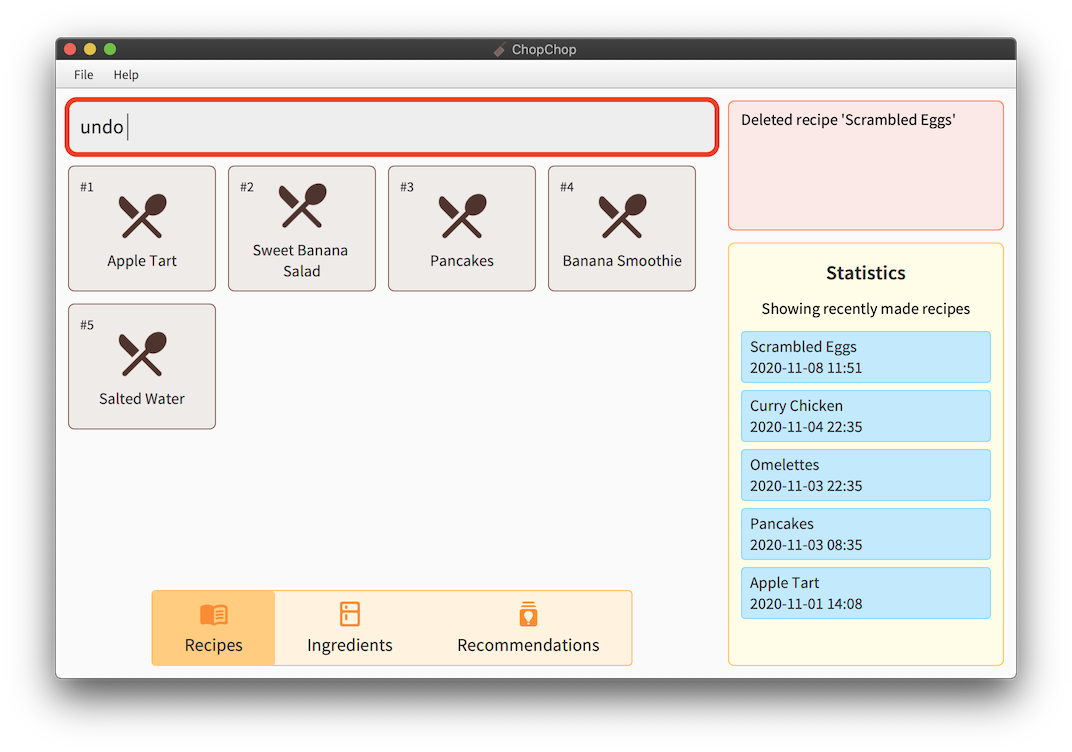
Figure 3.2: Simply use the `undo` command
After pressing enter, notice that the Scrambled Eggs recipe is back:
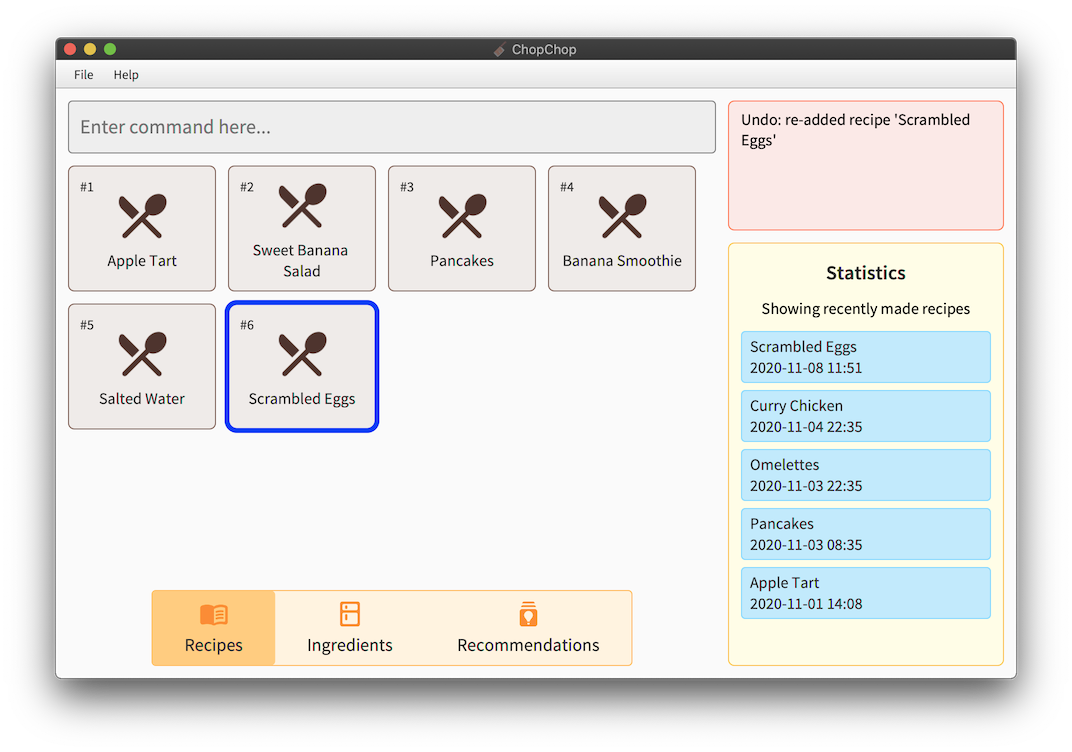
Figure 3.3: The scrambled eggs were saved
5.3.4 Redoing Commands — redo
This command redoes the last redoable command, effectively functioning as an undo for undo itself. All undoable commands (as described above) can be redone.
Usage: redo
For example, let’s say that you changed your mind, and you didn’t really want those scrambled eggs anyway; you can use redo to redo the deletion of that recipe:
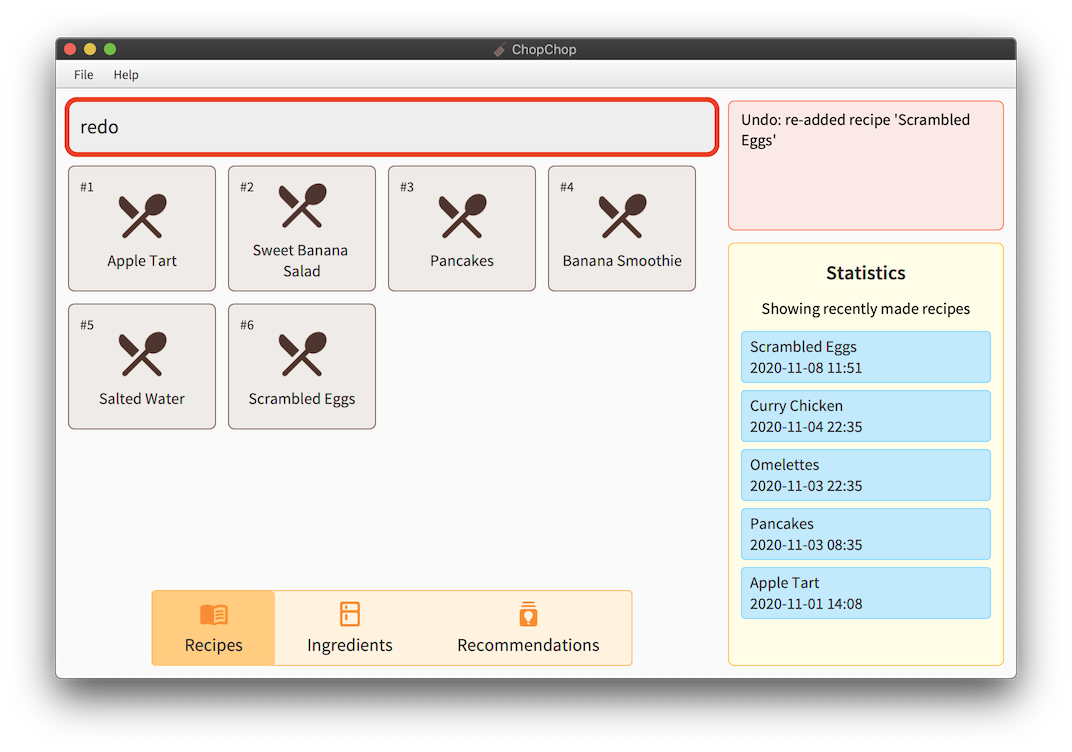
Figure 4.1: The scrambled eggs will be deleted again
After pressing enter, the scrambled eggs are now deleted:
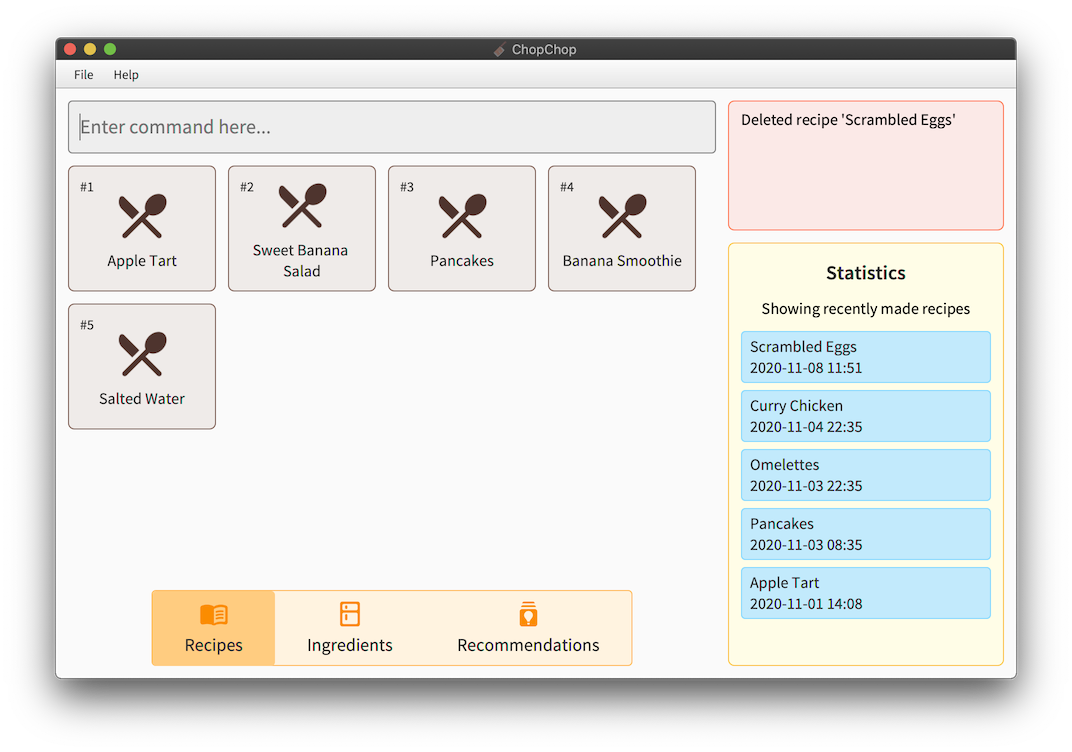
Figure 4.2: The scrambled eggs are now gone
5.3.5 Listing Recommendations — listrecommendations
This command allows you to switch to the recommendations pane, to view recipe recommendations. There are currently two types of recommendations that ChopChop will make:
- Recipes that only use ingredients you have in stock
- Recipes that use ingredients that are about to expire
In the second case, only ingredients that expire within the next week will be taken into account.
Usage: list recommendations
list recommendations or list recommendation.
In this example, ChopChop knows about some Milk that is about to expire within the next week (say, for example, it is the 4th of November):

Figure 5.1: There's some milk expiring on the 9th of November
Then, in addition to showing recipes using in-stock ingredients, it also highlights the Pancake recipe, which uses milk:

Figure 5.2: The recommendations view
5.4 Recipe Commands
These commands allow you to add, delete, edit, view, and make recipes.
5.4.1 Viewing Recipes — viewrecipe
This command opens the detailed view for the given recipe, allowing you to see its steps, ingredients, and tags.
Usage: view recipe <#REF>
Examples:
-
view recipe #1
This displays the first recipe currently shown in the recipe list. -
view recipe pancakes
This displays the recipe named ‘pancakes’. Note that the name here is case insensitive.
To illustrate, in the scenario below, both #1 and pancakes will refer to the same recipe:
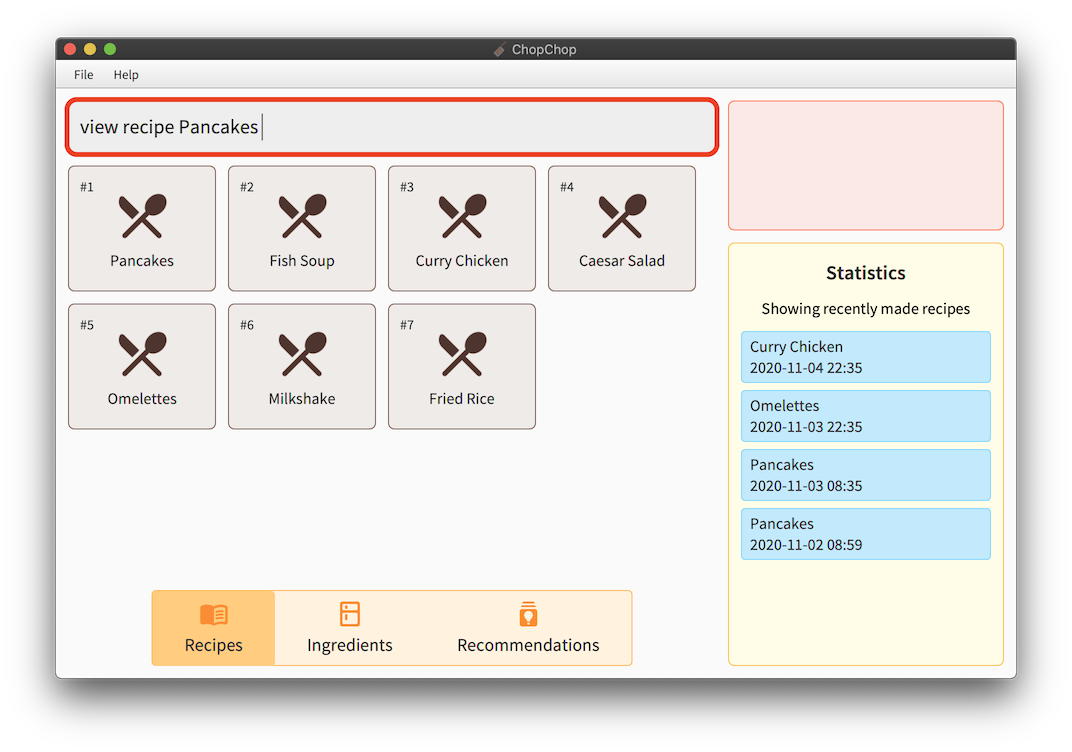
Figure 6.1: The recipe list view
After pressing enter, you will see this view, showing the recipe you wish to view:
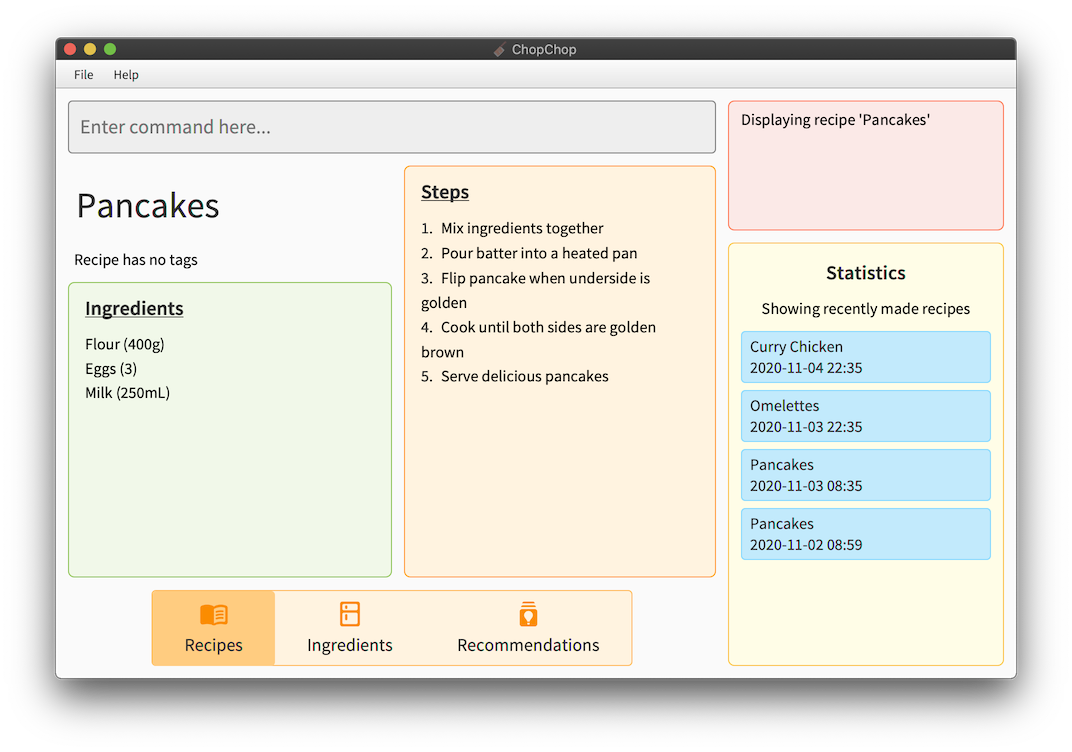
Figure 6.2: The detailed recipe view
5.4.2 Listing Recipes — listrecipes
This command shows a list of all recipes in ChopChop. You can use this to switch panes (between recipes and ingredients) without using the mouse, as well as to clear any filters that might have been applied due to previous commands (eg. find and filter).
Usage: list recipes
list recipes or list recipe.
Executing this command simply brings you back to the recipe list view:
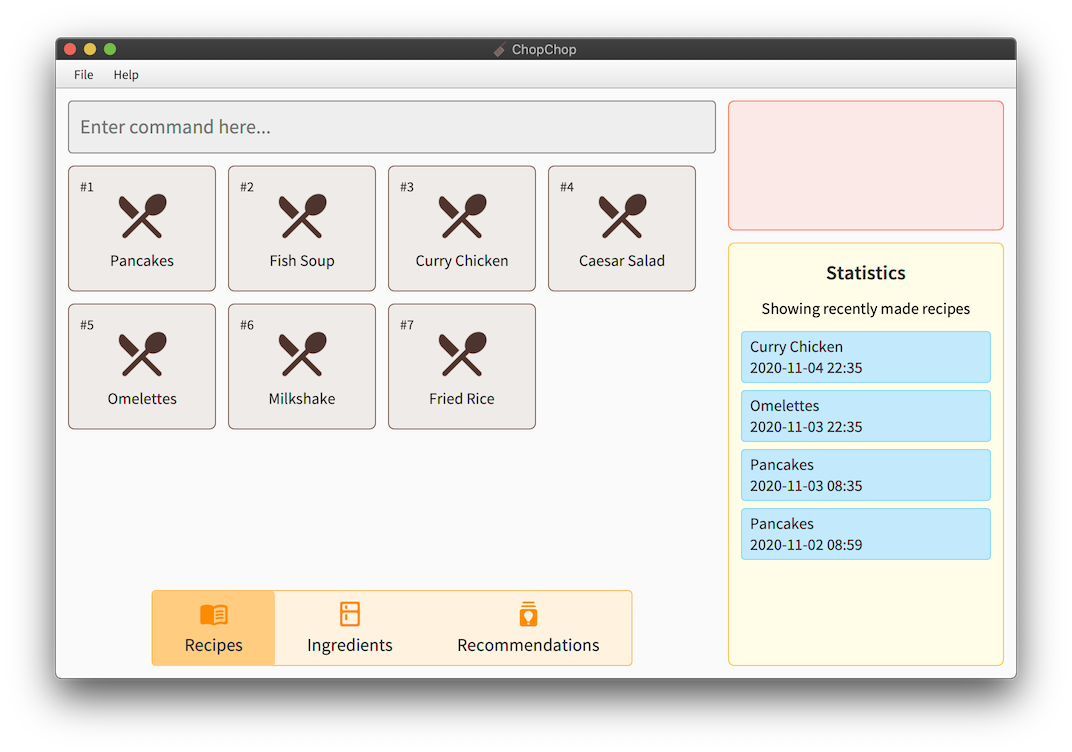
Figure 7: The recipe list view
5.4.3 Adding Recipes — addrecipe
This command adds a recipe to ChopChop, and you can specify zero or more ingredients, each with an optional quantity, and zero or more steps. After a recipe is added, you will be able to see it immediately.
Usage:
add recipe <name>
[/ingredient <ingredient-name> [/qty <quantity>]]...
[/step <step>]...
[/tag <tag-name>]...
Constraints:
- Recipe name must not be empty
- Ingredient names must not be empty
- Steps must not be empty
- Tag names must not be empty
- Quantities (
/qty) must only appear after an/ingredient
If an ingredient is specified without a quantity, it is treated as if you used /qty 1. This works for counted ingredients (eg. eggs), but it will cause errors for other ingredients (eg. volume of milk).
If the ingredient does not currently exist in ChopChop, it is still okay to add a recipe using it (you might add it later). Recipes are only checked for correctness when you try to make them.
For example, suppose you wanted to add a recipe for pancakes using flour, eggs, and milk, you would type this:
add recipe Pancakes
/ingredient flour /qty 400g
/ingredient egg /qty 3
/ingredient milk /qty 250ml
/step Mix ingredients together
/step Bake for 30 minutes at 400 celsius
/step Pour syrup and serve
(note that this is displayed on separate lines for clarity, but you should type this in one go)
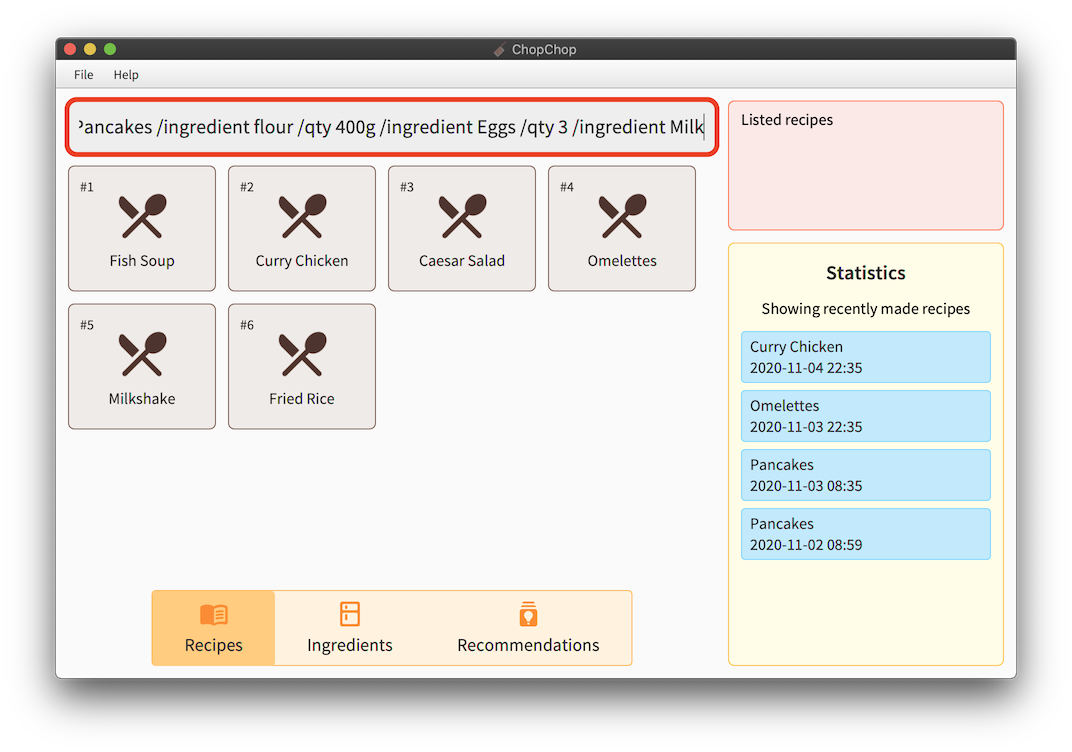
Figure 8.1: The add recipe command
After pressing enter, you will see this view, showing your newly created recipe:
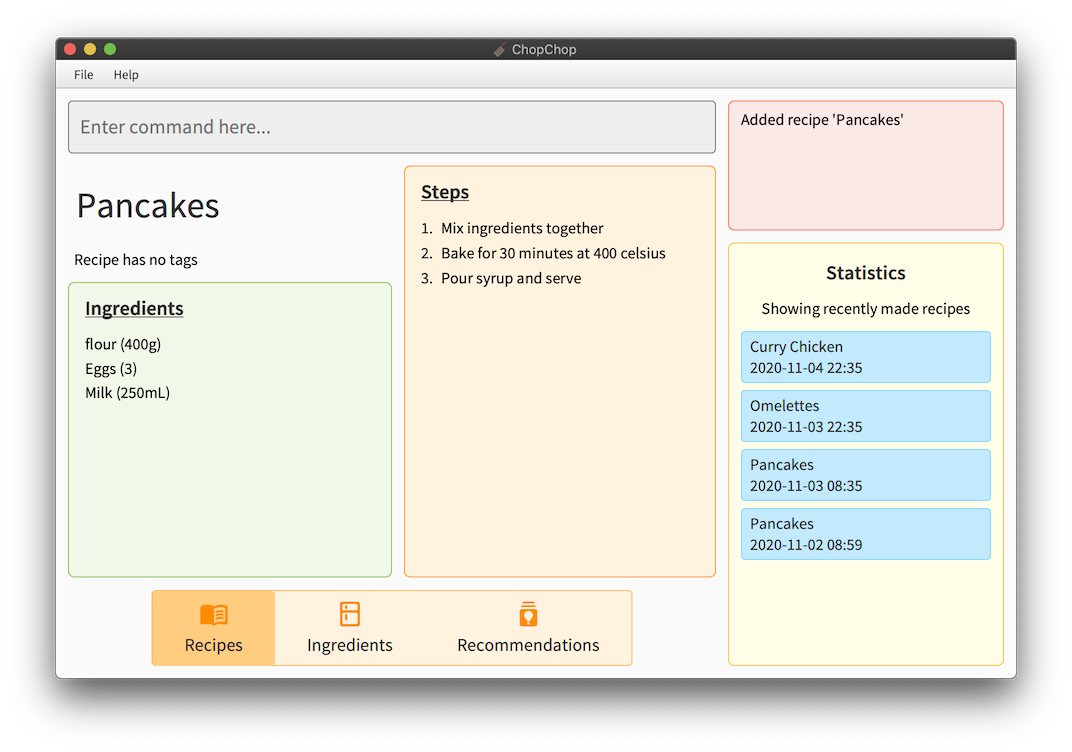
Figure 8.2: The recipe detail view
If you go back to the main recipe view (either by clicking on the tab at the bottom, or by using list recipes, you can see the new recipe in the list (ChopChop won’t actually highlight it, but we do here for clarity):
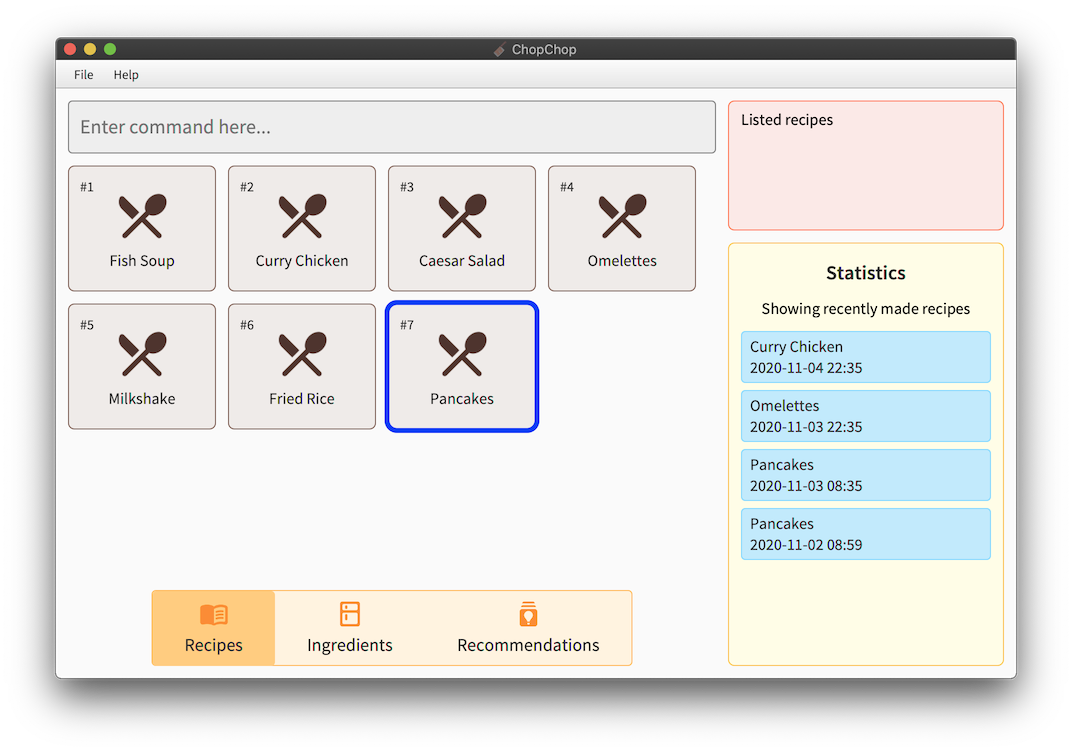
Figure 8.3: The newly created recipe in the recipe list
5.4.4 Editing Recipes — editrecipe
This command edits a specific recipe in ChopChop, letting you perform different actions on the name, ingredients, steps, and tags, as specified below.
To accommodate the various different kinds of editing operations, ChopChop has special syntax for editing, known as edit-arguments, eg. /step:add. The component following the colon is the ACTION, which can take these values:
- For ingredients and steps, it can either be
add,edit, ordelete. - For tags, it can be either
addordelete.
Name
If you want to edit a recipe’s name, simply use /name, for example /name new recipe name.
Ingredients
If you want to edit a recipe’s ingredients, use /ingredient with the corresponding action (eg. /ingredient:add).
When adding or editing ingredients, a /qty must be specified after the ingredient. Here are some examples:
-
/ingredient:add milk /qty 500ml
This makes the recipe require 500ml of milk; if the recipe already used milk, then an error is displayed — here, you should use/ingredient:editinstead. -
/ingredient:edit beef /qty 200g
This changes the quantity of beef used in the recipe from its previous value to 200 grams. If the recipe did not use beef as an ingredient, an error is displayed — here, you should use/ingredient:addinstead. -
/ingredient:delete carrot
This removes carrots from the recipe entirely. If the recipe did not use carrots, then an error is displayed.
Tags
If you want to edit the tags for a recipe, use /tag with the corresponding action, which are either add or delete. For example:
-
/tag:add vegetarian
This adds the ‘vegetarian’ tag to the recipe. If the recipe already contains this tag, an error is displayed. -
/tag:delete cold
This removes the ‘cold’ tag from the recipe. If the recipe did not have this tag, an error is displayed.
Steps
Since steps have a fixed ordering in a recipe, editing them is slightly more involved; when editing or deleting steps, you are required to provide the step number as an additional component in the edit-argument. For example, /step:edit:3 edits the third step in the recipe.
When adding a step, the step number is optional; if not specified, the new step will be added as the last step. If it is specified, then the new step will be inserted at the corresponding position, and the following steps will be re-numbered.
For example:
-
/step:add Bake for 80 minutes at 400 C
This adds a new step as the last step of the recipe. -
/step:edit:4 Bake for 50 minutes at 250 C
This changes the content of step number 4. -
/step:delete:1
This deletes the first step of the recipe.
Note that steps must be added sequentially; for instance, you cannot add step 5 to a recipe with only 2 steps.
Usage
Except /name (which can only appear once), all of the edit operations described above can appear multiple times, in any order, in a single edit recipe command. Each operation is processed sequentially from left-to-right, so if two operations modify the same item, then the second one will take precedence.
(As an example, /step:edit:3 Bake ... /step:edit:3 Fry will cause step 3 to be ‘Fry’)
Usage:
edit recipe <#REF>
[/name <new-recipe-name>]
[/ingredient:<action> <ingredient-name> [/qty <quantity>]]...
[/step:<action>[:<index>] <step>]...
[/tag:<action> <tag-name>]...
Examples:
-
edit recipe #4 /name soup
This changes the name of the fourth recipe in the recipe list to ‘soup’. -
edit recipe pancakes /ingredient:add syrup /qty 500ml
This edits the recipe named ‘pancakes’ by adding 500ml of syrup to its ingredient list. -
edit recipe risotto /step:edit:1 In a saucepan, warm the broth over low heat
This edits the recipe named ‘risotto’ by changing the 1st step to the text above. -
edit recipe beef curry /ingredient:delete apple /step:delete:4
This edits the recipe named ‘beef curry’ to remove both the ingredient ‘apple’ as well as the 4th step.
To illustrate how to use this powerful command, let us recreate the Pancake recipe from above, starting from a blank recipe instead. First, we make the empty recipe using add recipe Pancakes:
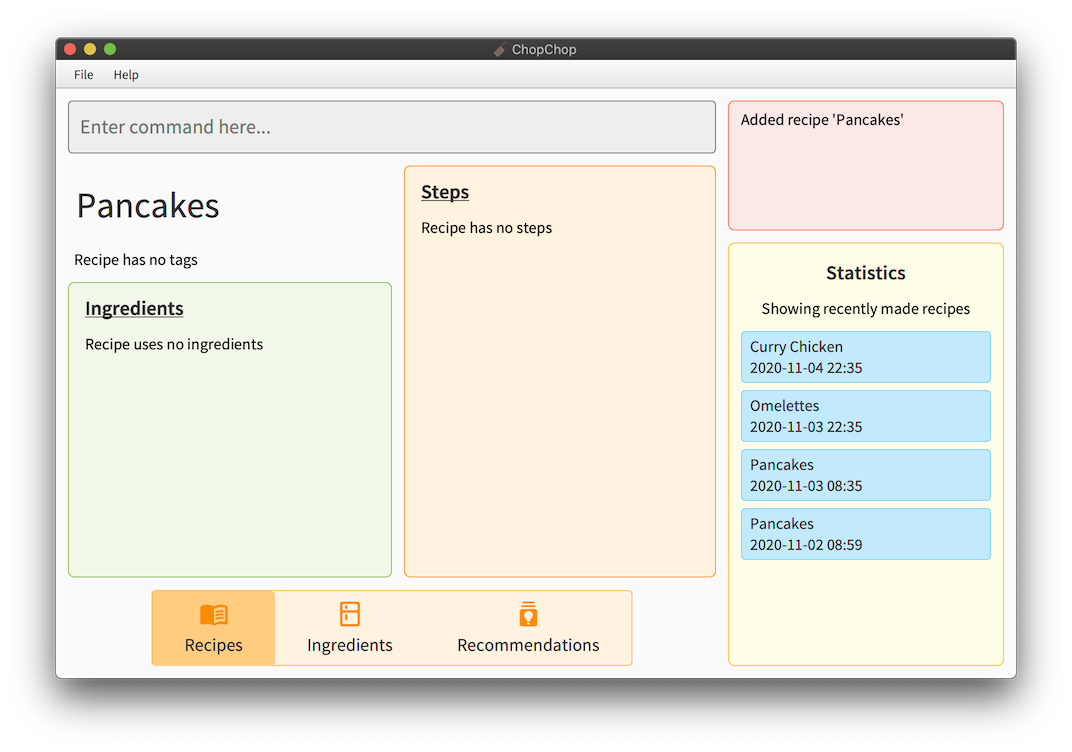
Figure 9.1: The empty recipe
Now, let’s add our ingredients, using /ingredient:add; first, 400 grams of flour:
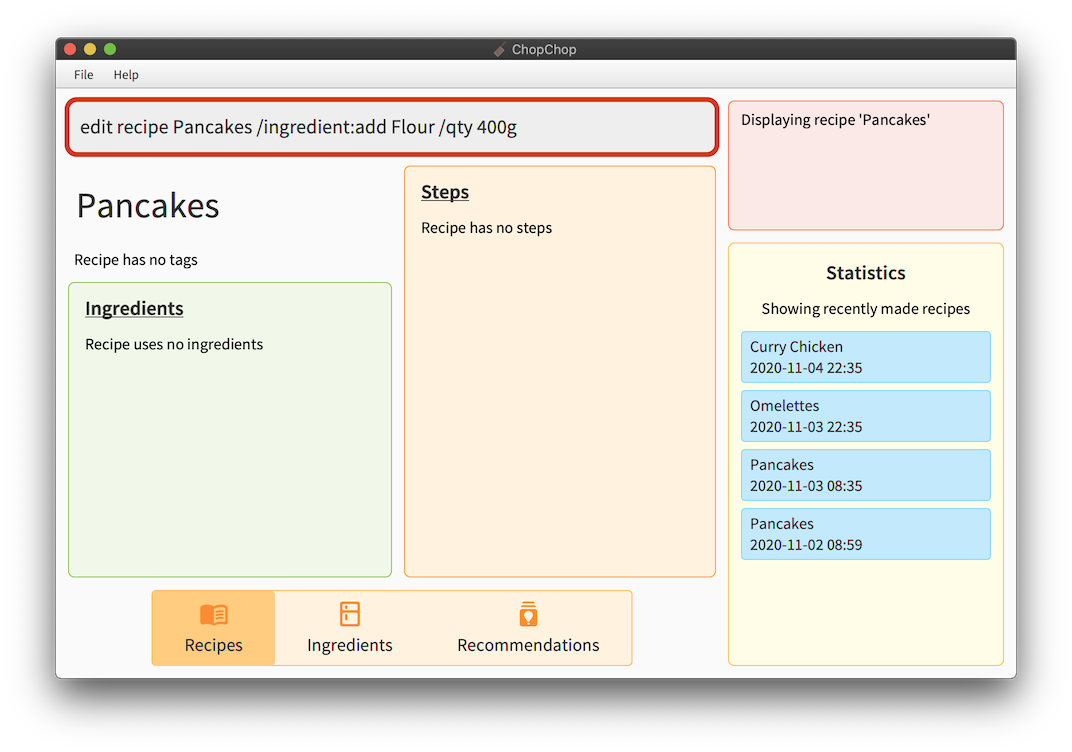
Figure 9.2: The command to add a new ingredient to the recipe
Next, adding the eggs and milk in one go:
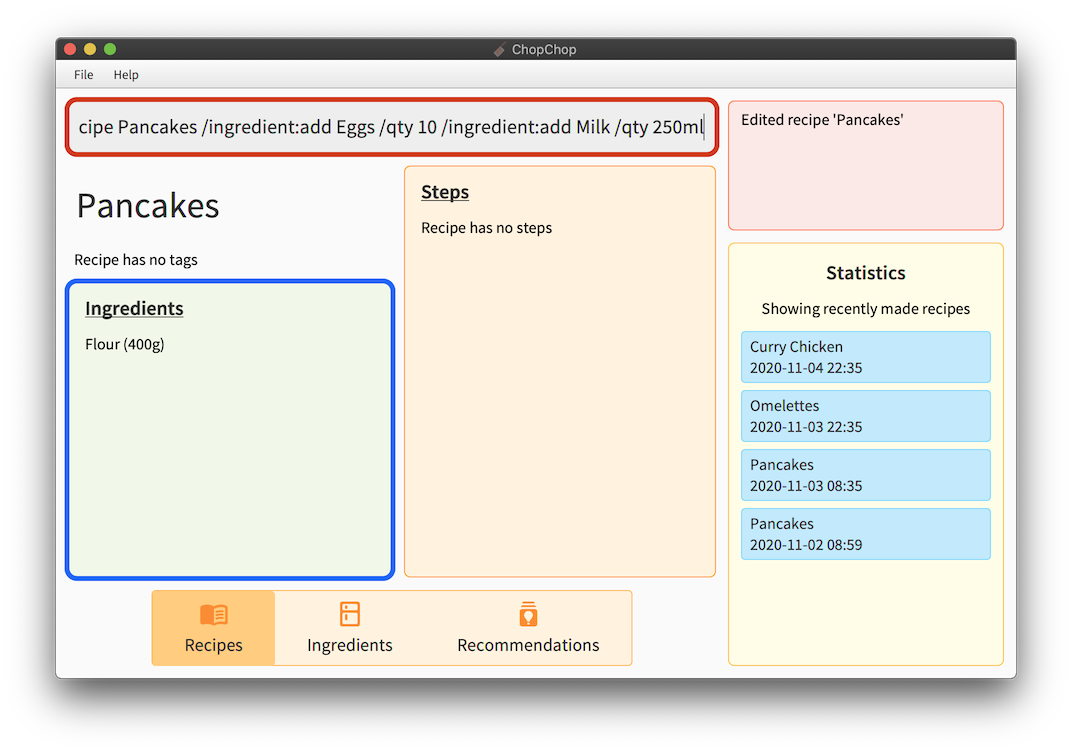
Figure 9.3: The edit command supports multiple operations at once
Oops, that’s too many eggs, so let’s edit the quantity using /ingredient:edit:

Figure 9.4: Editing an ingredient to change its quantity
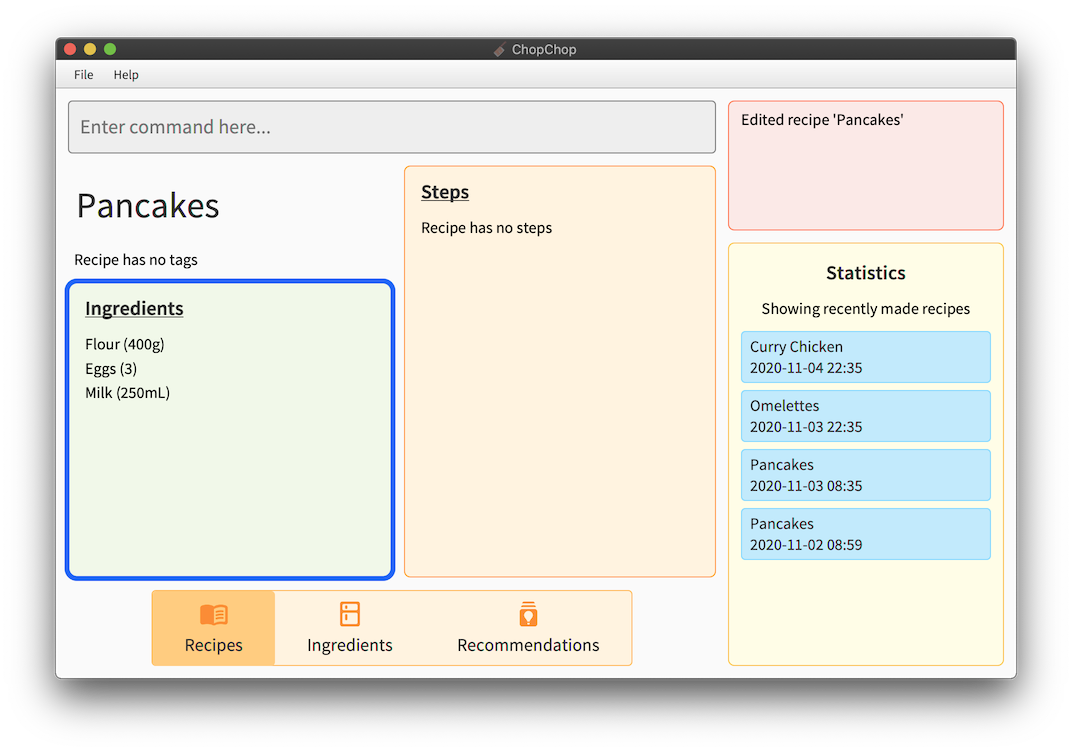
Figure 9.5: The recipe now uses only 3 eggs
Now let’s add the steps with /step:add:

Figure 9.6: Multiple steps can be added at the same time
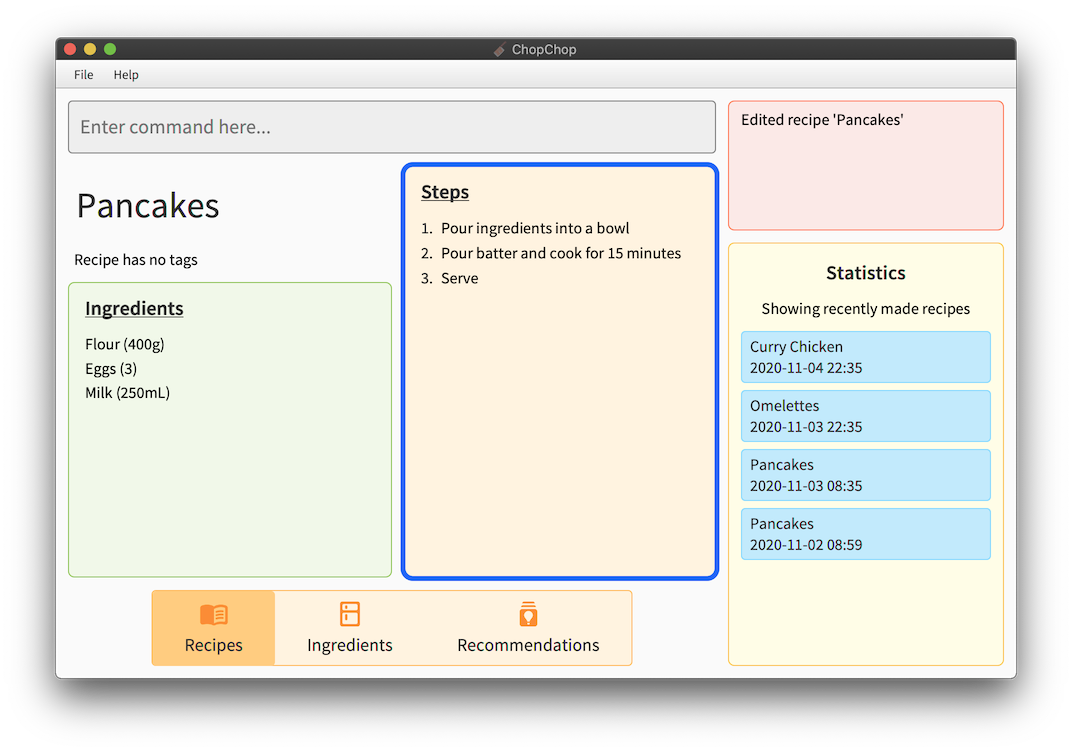
Figure 9.7: The finished recipe
Wait, we forgot to mix the ingredients together! Let’s fix it by inserting a new step 2 with /step:add:2:
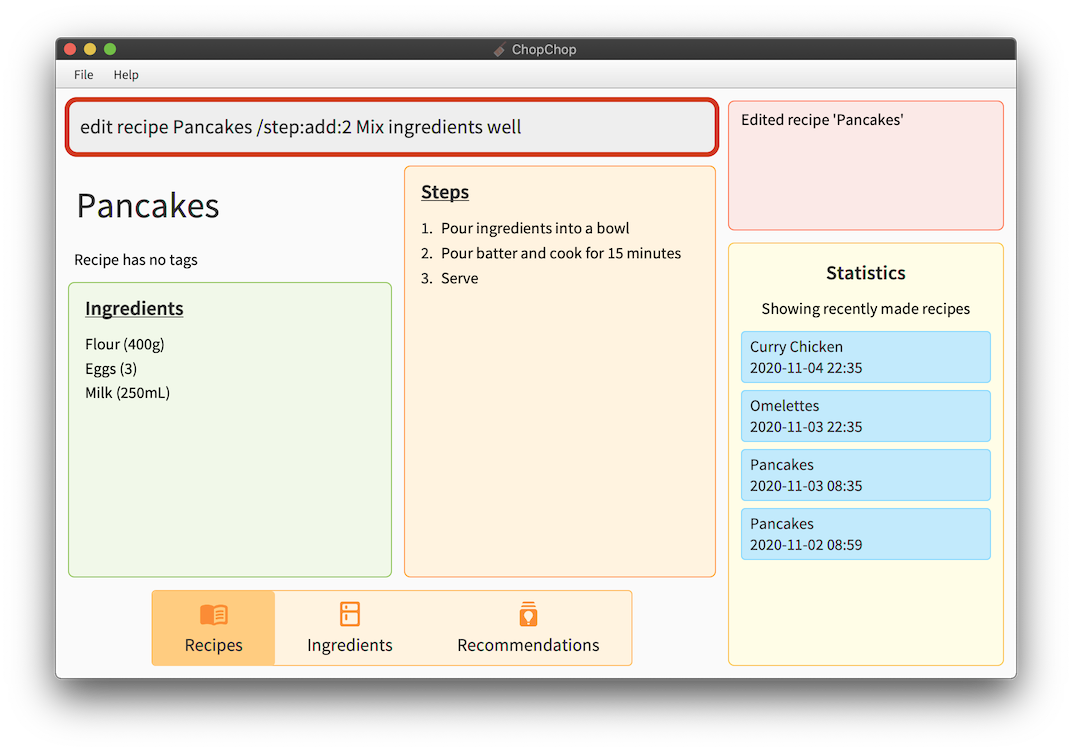
Figure 9.8: Adding a new step in the second position
Oh no, we also forgot the most important thing — syrup! So let’s modify the last step (4) to include syrup with /step:edit:4:
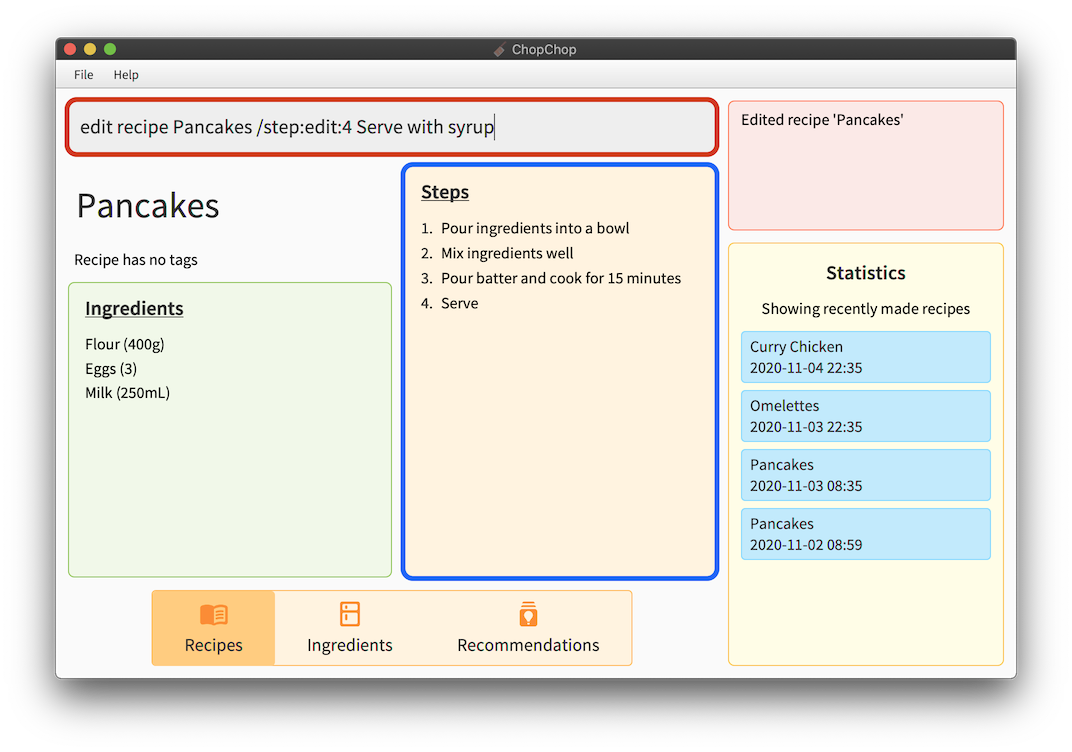
Figure 9.9: Editing the last step
And now the pancake recipe is complete!
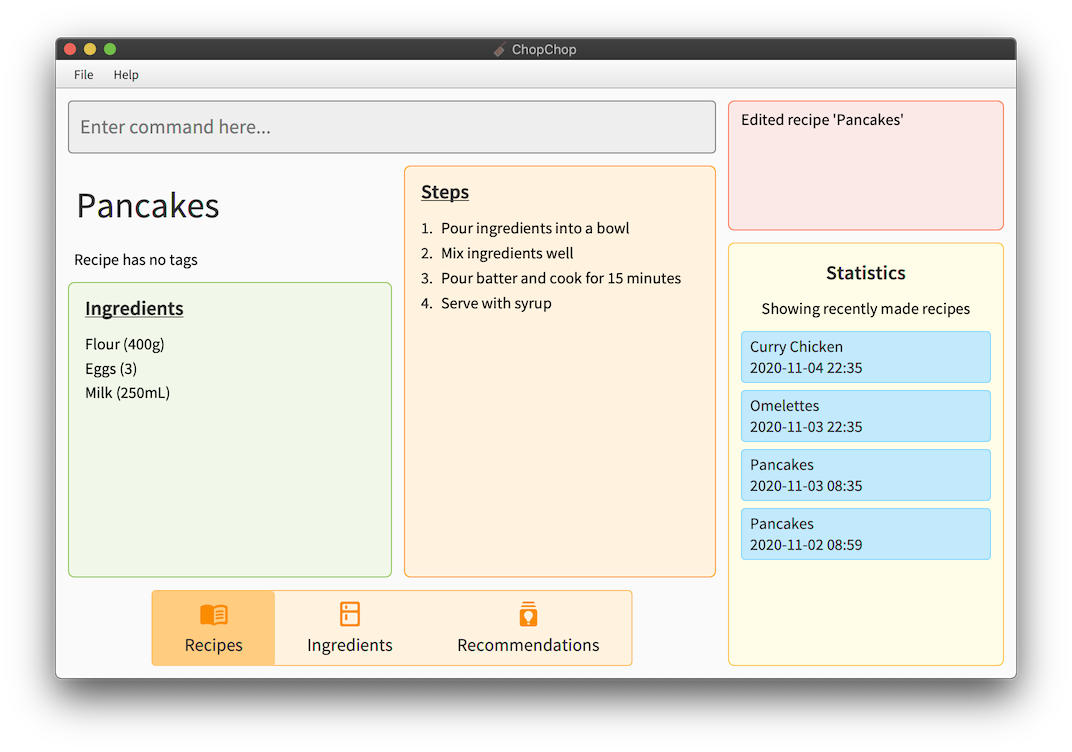
Figure 9.10: The finished recipe
5.4.5 Deleting Recipes — deleterecipe
This command deletes a specific recipe from ChopChop. Don’t worry if you did this accidentally, because commands can be undone! (see: undo).
Usage: delete recipe <#REF>
Examples:
-
delete recipe #4
This deletes the fourth recipe in the recipe list. -
delete recipe pancakes
This deletes the recipe named ‘pancakes’. Note that the name here is case insensitive.
In this example, both delete recipe #7 and delete recipe pancakes will delete the Pancakes recipe:
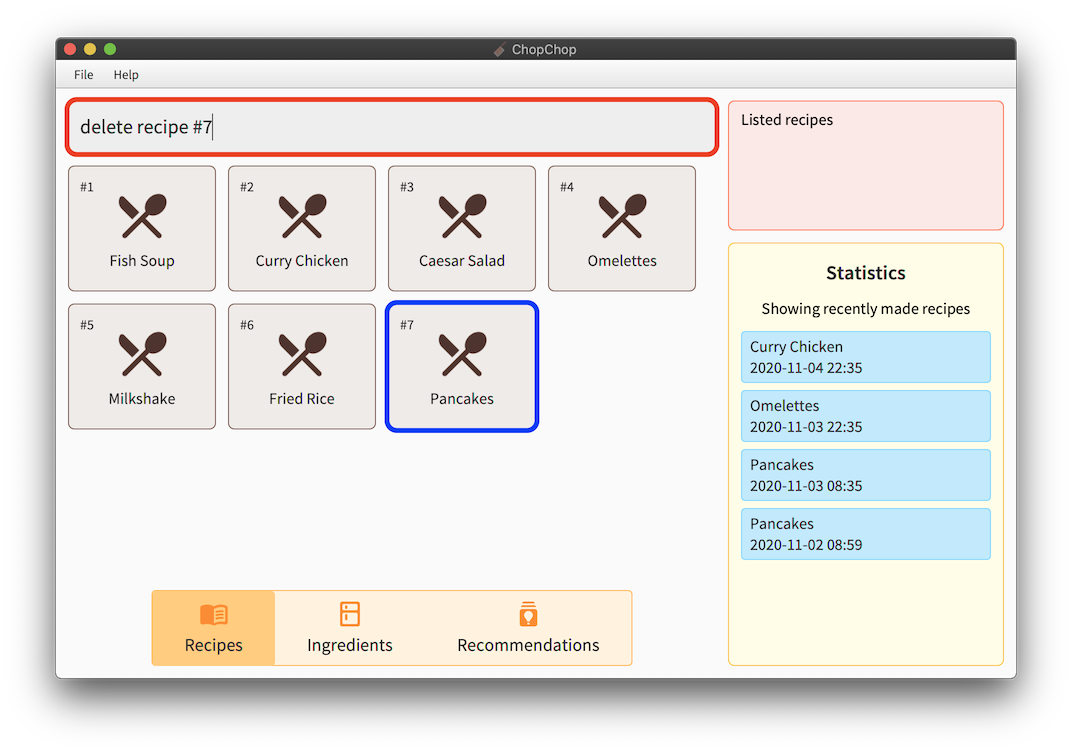
Figure 10: The pancakes recipe can be referred to either by name or by number
5.4.6 Finding Recipes — findrecipe
This command finds all recipes containing the given keywords in the name.
Usage: find recipe <keyword> [<keyword>]...
Constraints:
- At least one search keyword must be given
Only the recipe name is searched, and only full words are matched, case-insensitively. In the case of multiple search keywords, recipes containing any of those words will be returned.
Examples:
-
find recipe cakewill match Chocolate Cake and Strawberry Cake, but not Pancakes. -
find recipe milk cakewill match Milk Tea and Carrot Cake.
To illustrate, suppose you want to search for recipes with names containing ‘cake’, you would use find recipe cake:
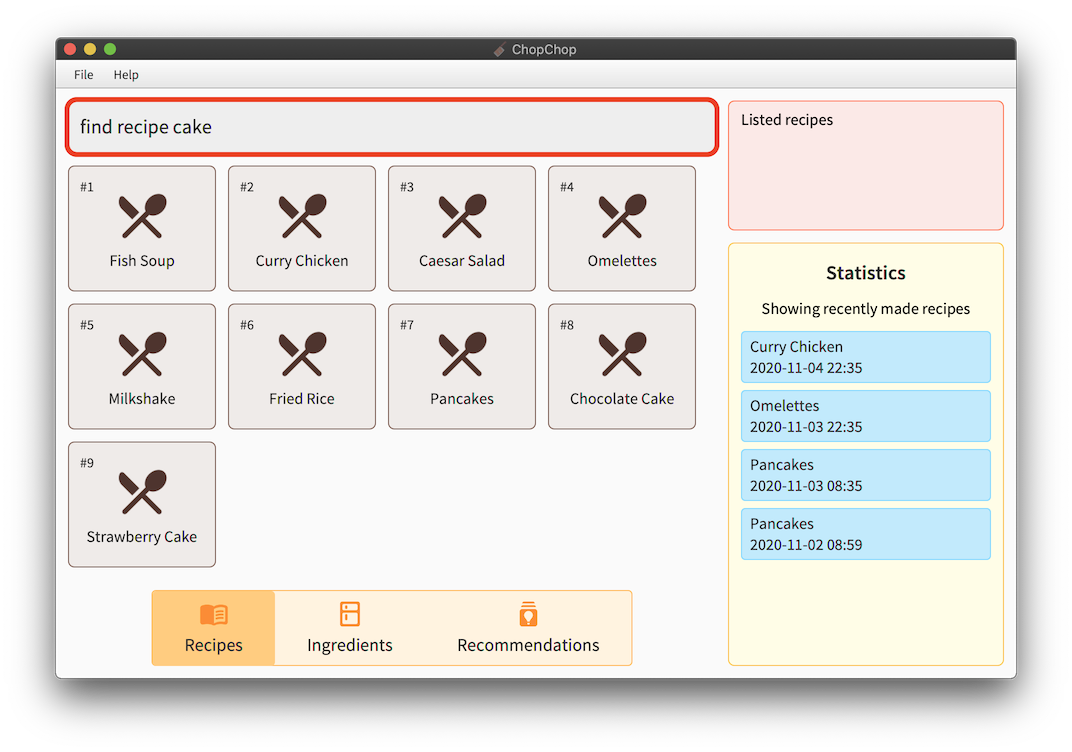
Figure 11.1: The initial list of recipes
After executing the command, note how the recipe list has changed, showing only the matching recipes, and that the item numbers in the corners have changed as well. As explained above, the ‘Pancakes’ recipe was not included in this list:
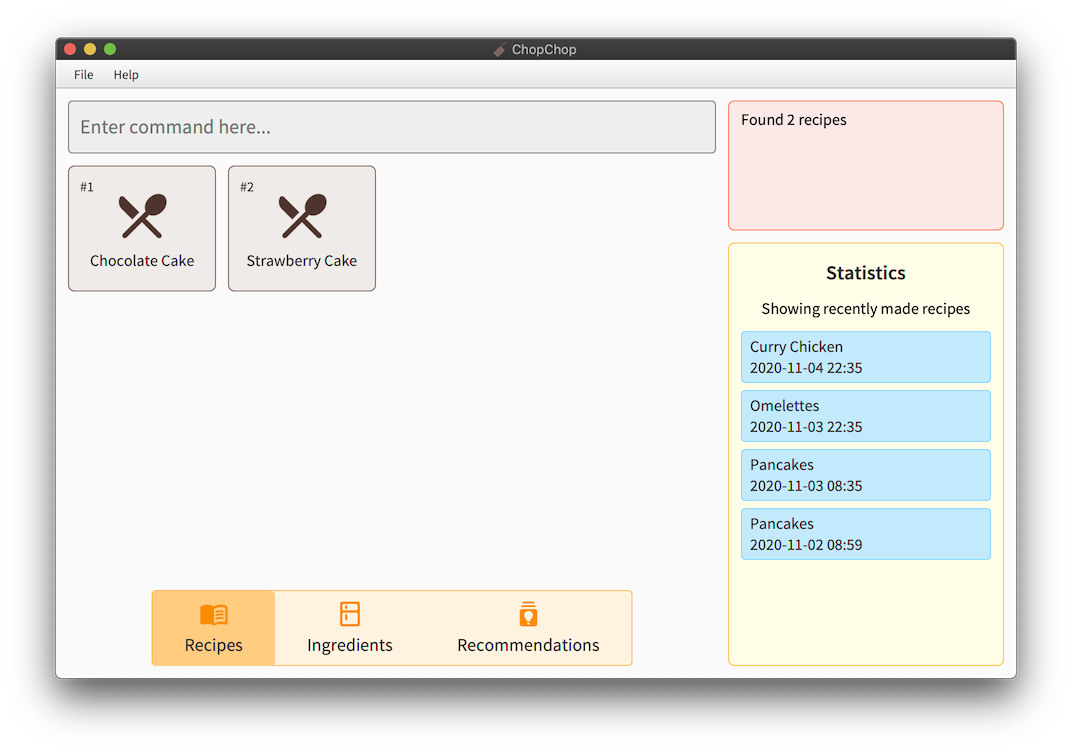
Figure 11.2: The recipes containing 'cake'
To go back to the full recipe view (resetting the search filter), you can either click the Recipes button at the bottom, or run the list recipes command:
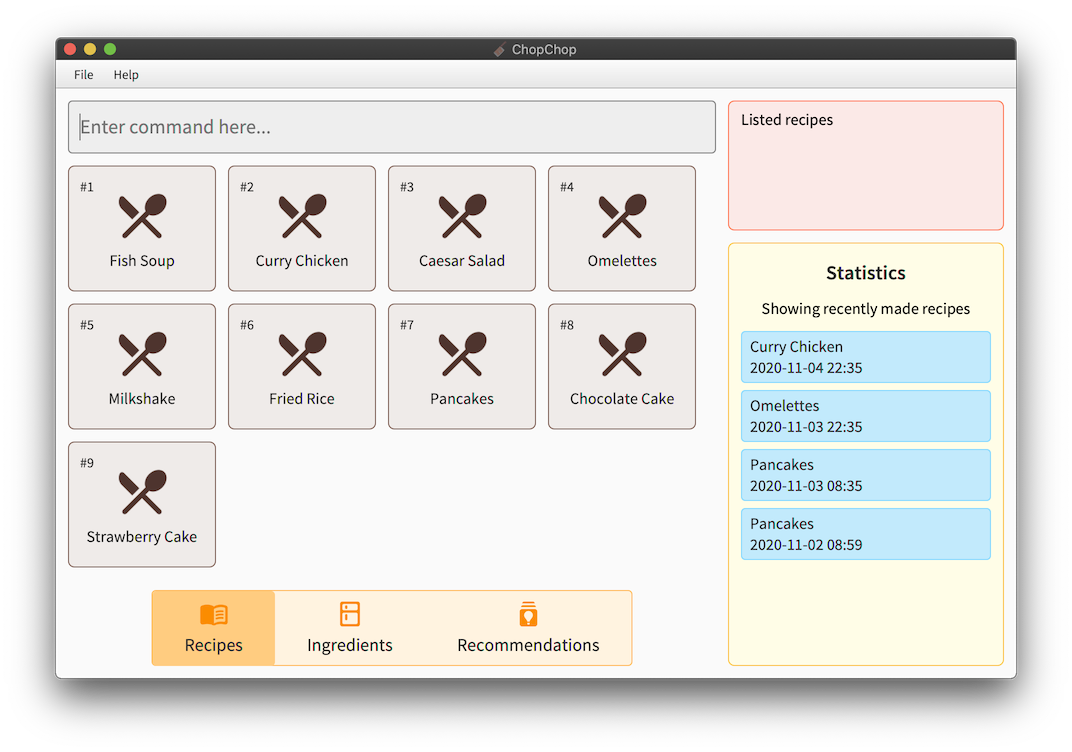
Figure 11.3: Back to the main recipe list
5.4.7 Filtering Recipes — filterrecipe
This command filters all recipes and lists those containing the given name, tag and ingredient keywords. Unlike the find recipe command, the search terms here have to all match a recipe for it to be found.
Usage:
filter recipe
[/name <name-keywords>...]...
[/tag <tag-keywords>...]...
[/ingredient <ingredient-keywords>...]...
- Keywords do not have to be complete to match the ‘name’, ‘tag’ or ‘ingredient’ names.
- Multiple search terms from the same category are allowed. e.g.
/tag movie /tag family - Search terms can be placed in any order.
- The filtering is case-insensitive and allows spaces between keywords in a single search term. e.g.
/tag family favouriteis allowed.
Constraints:
- At least one search term must be given, and they should be either
/name,/tagor/ingredient. - Search terms must not be empty.
Examples:
-
filter recipe /name ginger
This matches Gingerbread Man and Ginger Chicken Soup, the only recipes whose names include ginger. -
filter recipe /name sweet /name cake
This matches Sweet Choco Cake and Sweet Caramel Cake, the only recipes whose names include both sweet and cake. -
filter recipe /tag family reunion
This matches Spring Rolls and Hot Pot, the only recipes tagged family reunion. -
filter recipe /tag snacks /tag sweet
This matches Chocolate Cookie and Gummy Bears, the only recipes tagged both snacks and sweet. -
filter recipe /ingredient eggs
This matches Egg Tart and Scrambled Eggs, assuming they are the only recipes using eggs. -
filter recipe /ingredient chicken /ingredient cheese /ingredient pineapple
This matches Chicken Quesadilla, assuming it is the only recipe using chicken, cheese, and pineapple. -
filter recipe /tag local dish /name chicken /ingredient chicken /ingredient white rice /tag family favourite /name rice
This matches Chicken Rice, assuming it is the only recipe that matches all the criteria specified.
To illustrate, suppose you had the following two recipes:
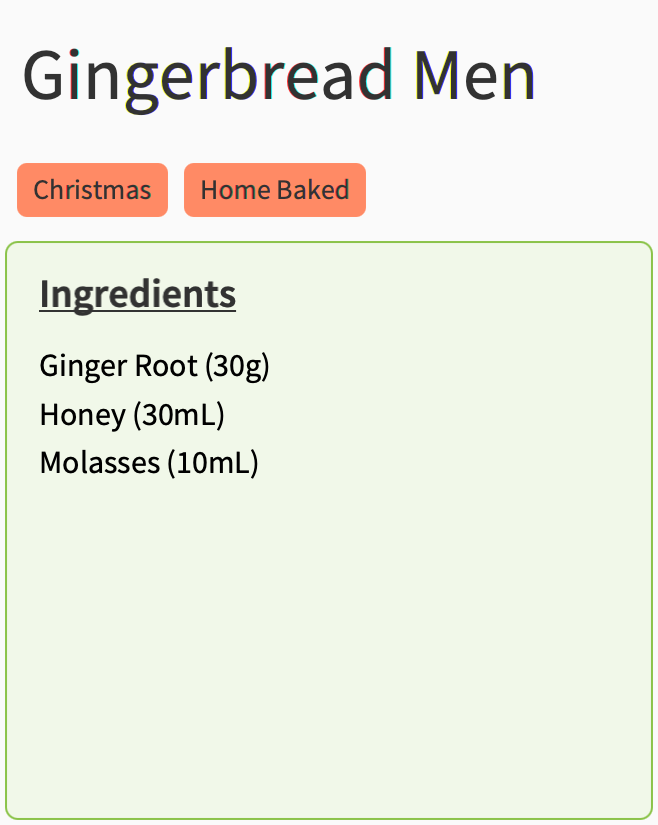
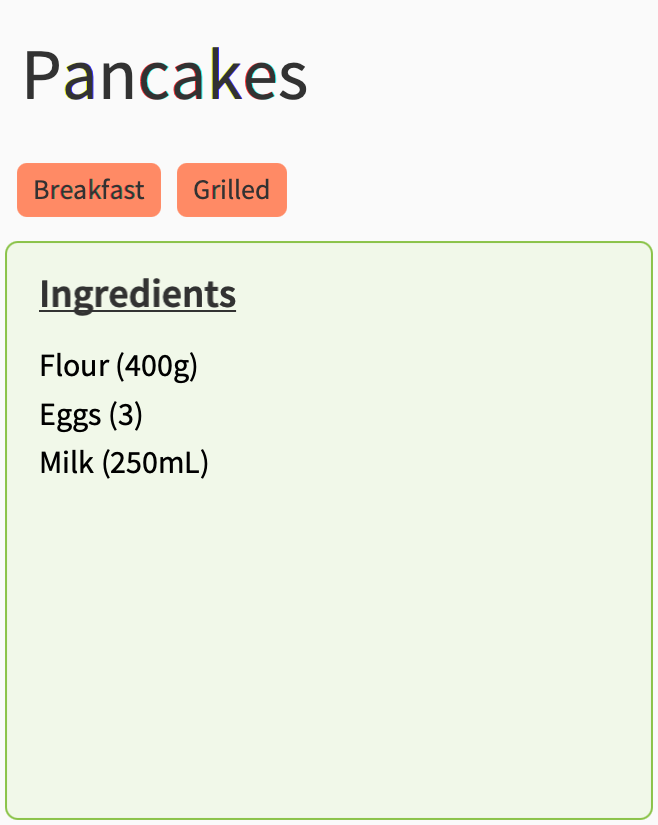
Figure 12.1: The starting recipes
Then, if you wanted to search for recipes with tags christmas and baked, using ingredients honey, ginger root, and molasses, and whose names contain keywords men and bread, you would use this command (separated into lines for clarity):
filter recipe
/name men /name bread
/tag christmas /tag baked
/ingredient honey /ingredient ginger /ingredient molasses
After executing the command, similar to the effect of find recipe command, the recipe list has changed, showing only the matching recipe, Gingerbread Men:
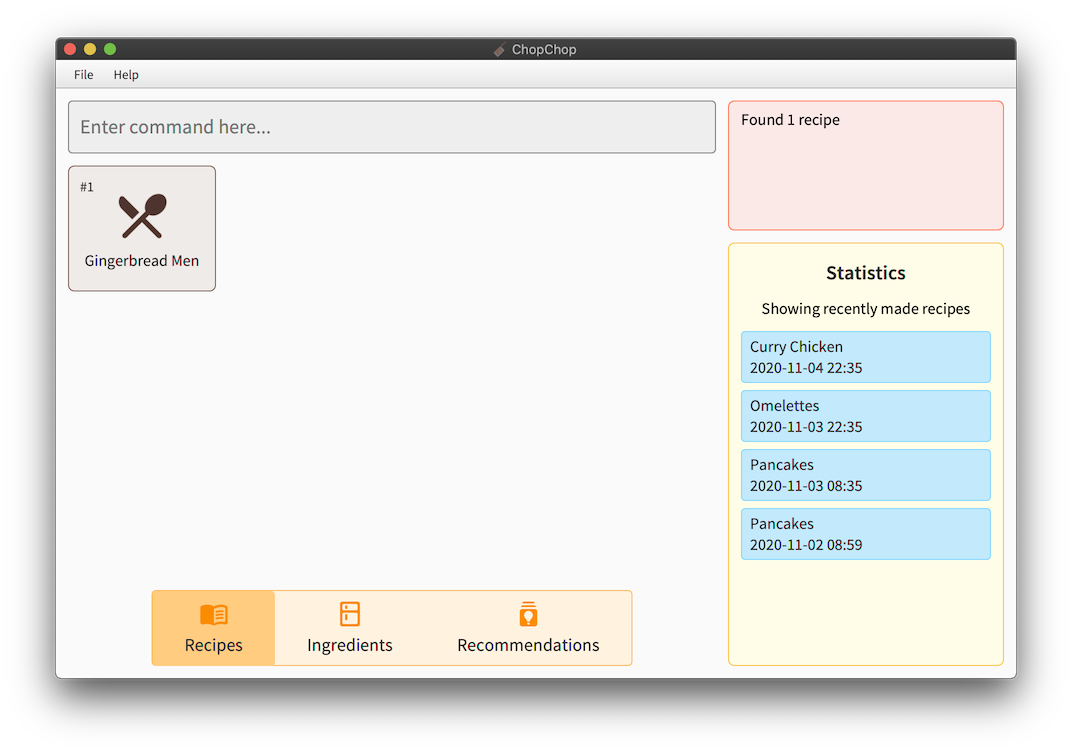
Figure 12.2: Only one recipe matched all the provided criteria
Note the following:
-
gingerfound the ingredient Ginger Root -
bakedfound the tag home baked -
menandbreadfound the name Gingerbread Men
To reset the search filter or go back to the full recipe view, you can click the Recipes button or run the list recipes command.
5.4.8 Making Recipes — makerecipe
This command allows you to make a recipe, which will add it to the statistics tracker, and deduct the appropriate amounts from ChopChop’s internal ingredient inventory.
If you do not have sufficient ingredients to make the recipe, an error message is shown. After the recipe is made, you will be brought to the ingredient list showing the updated ingredient amounts.
Usage: make recipe <#REF>
Examples:
-
make recipe pancakes
This makes the recipe named ‘pancakes’. Note that the name here is case insensitive.
To illustrate suppose you wanted to make the pancakes here, you would use make recipe pancakes. You can run this command from any view (not necessarily from the recipe detail view):
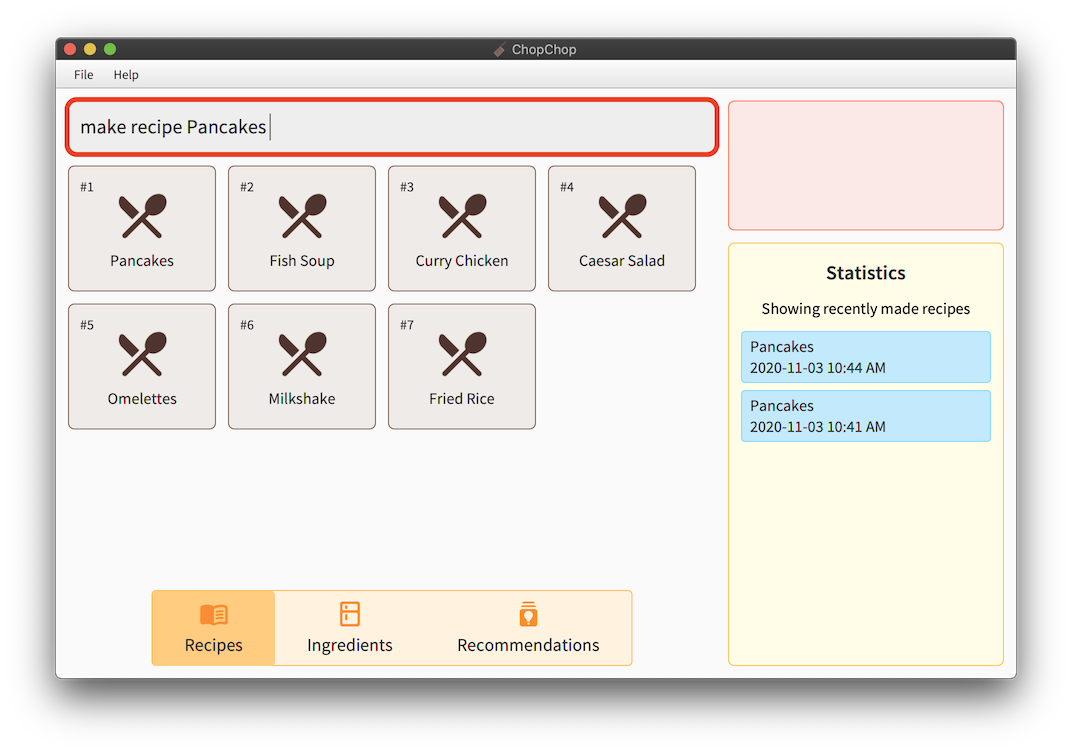
Figure 13.1: Making pancakes
After pressing enter, ChopChop will open up the recipe that you’ve just made:
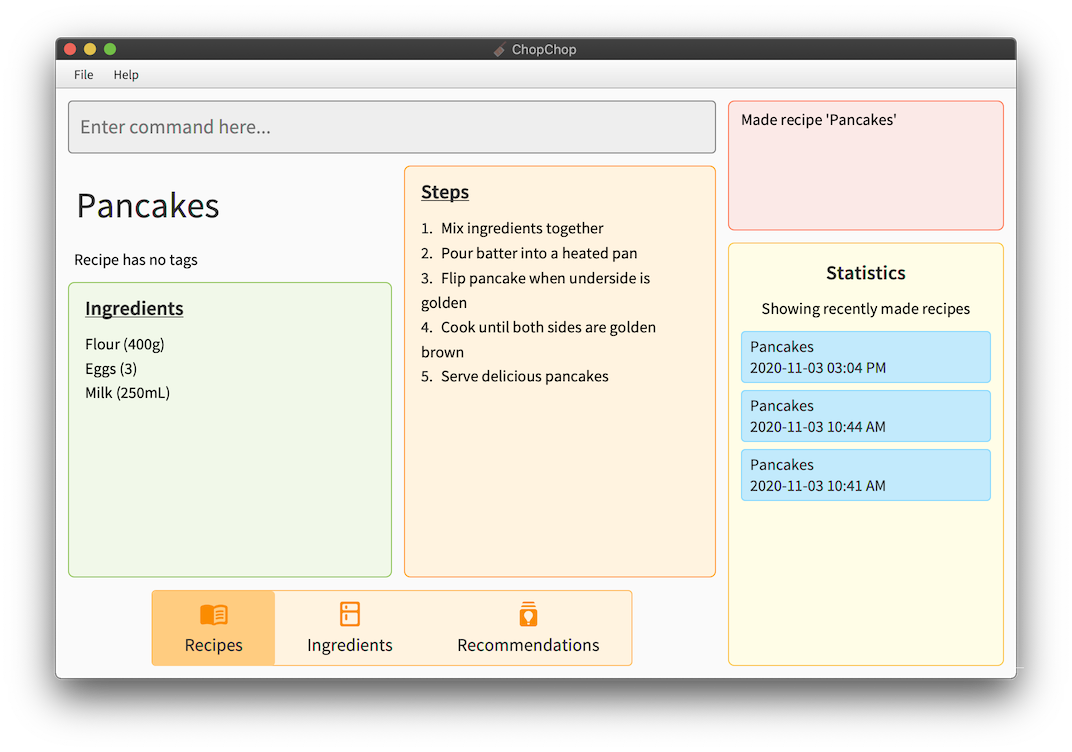
Figure 13.2: The detailed recipe view
If there are ingredients that are missing, or that you have insufficient amounts of, ChopChop will display this message in the command output window:
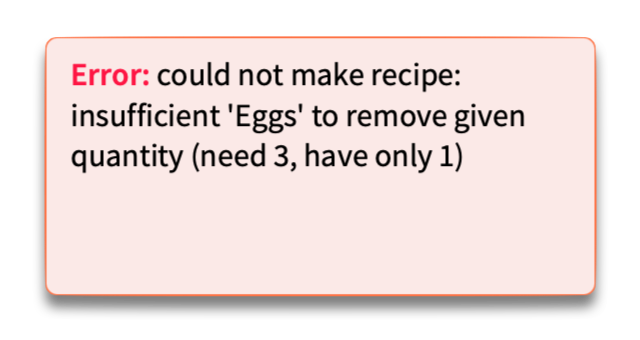
Figure 13.3: Insufficient ingredients to make the pancakes
Furthermore, if the recipe used ingredients having incompatible units with existing ingredients (eg. you have Butter in grams, but the recipe wants Butter in tablespoons), then an error is also shown. In this situation, you should edit the recipe so that it uses the correct units.
5.5 Ingredient Commands
These commands allow you to add, delete, and edit ingredients.
5.5.1 Listing Ingredients — listingredients
This command shows a list of all recipes in ChopChop. As with the list recipes command, you can use this command to switch between panes without clicking, or to reset any filters.
Usage: list ingredients
list ingredients or list ingredient.
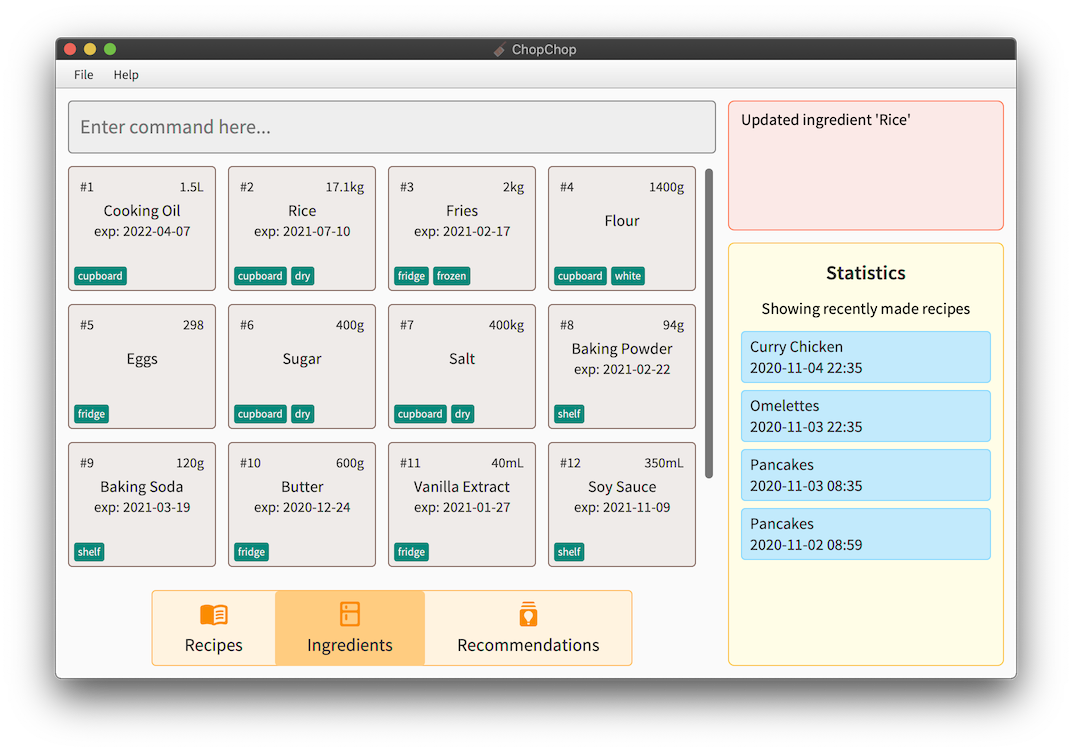
Figure 14: The ingredient list view
5.5.2 Adding Ingredients — addingredient
This command adds an ingredient to ChopChop, with an optional quantity and expiry date:
- If the quantity is not specified, ChopChop will infer 1 of a counted quantity, like eggs.
- If the expiry date is not specified, it is assumed that the ingredient (eg. salt) does not expire.
As mentioned in the overview above, an ingredient can consist of multiple sets; the add ingredient command will intelligently combine ingredients as appropriate.
If the new ingredient has /tag options that are not present in the existing ingredient, then they are added as well.
Usage:
add ingredient <name>
[/qty <quantity>]
[/expiry <expiry-date>]
[/tag <tag-name>]...
Examples:
-
add ingredient milk /qty 1l /expiry 2020-11-09adds one litre of milk that expires on the 9th of November. -
add ingredient egg /expiry 2020-12-25adds one egg that expires on Christmas day.
Suppose you just finished a grocery run, and want to add the items to ChopChop. First, you have 2 cartons of milk:
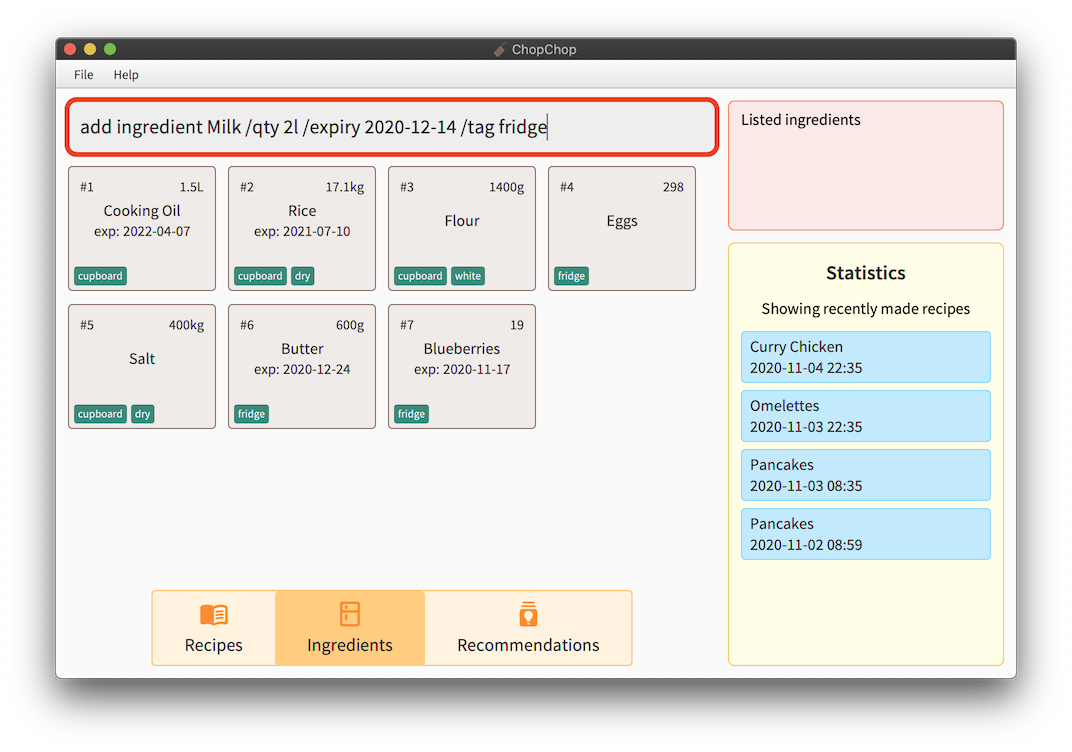
Figure 15.1: Adding 2 litres of milk
Since ChopChop did not know about ‘milk’ previously, a new ingredient entry is created for it:
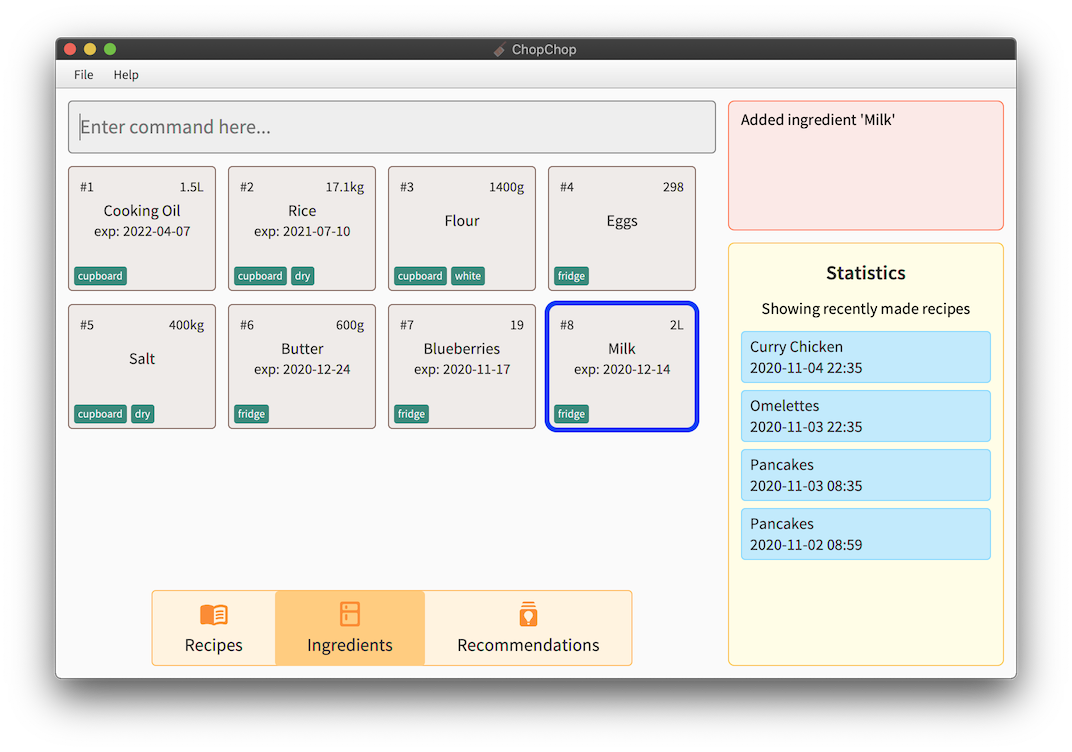
Figure 15.2: The newly added milk ingredient
Next, suppose you also bought 24 blueberries:

Figure 15.3: Adding 24 blueberries
This time, since ChopChop already knew about blueberries, our previous 19 blueberries now become 43:
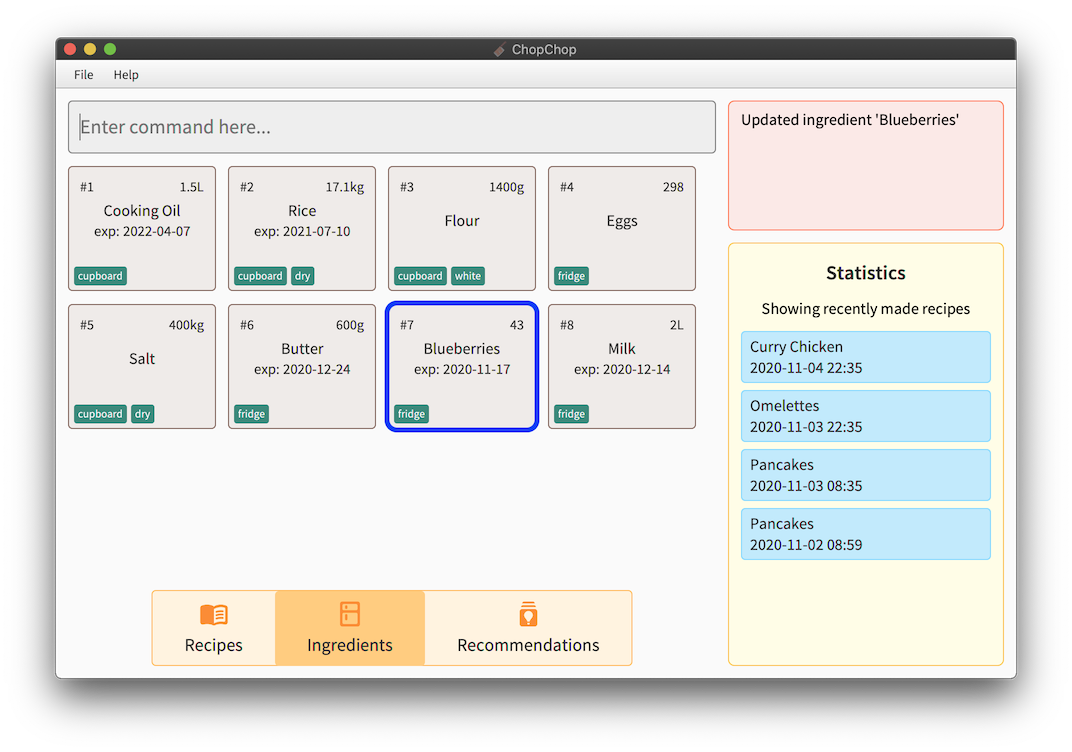
Figure 15.4: You now have 43 blueberries
If you try to add an ingredient with incompatible quantities (for example, suppose you did not want to count the blueberries individually, and you only know that you bought a 400 gram box), ChopChop will display an error message, and not update the ingredient:
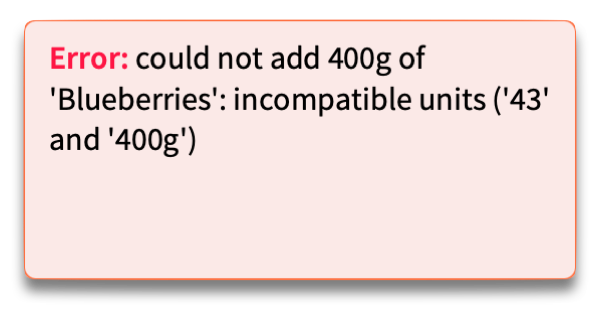
Figure 15.5: Ingredients must have compatible units to be combined
5.5.3 Deleting Ingredients — deleteingredient
This command deletes a specific ingredient from ChopChop. Similar to the add ingredient command, this command also allows you to delete quantities of ingredients instead of the whole ingredient. In this scenario, ChopChop will intelligently remove the earliest-expiring ingredients first.
If /qty is not specified, then the behaviour of this command is to completely remove the ingredient from ChopChop. Worry not: if you accidentally delete something, you can always undo it.
Usage: delete ingredient <#REF> [/qty <quantity>]
Examples:
-
delete ingredient #4
This deletes the fourth ingredient currently shown in the recipe list. -
delete ingredient milk /qty 500ml
This removes 500ml of milk from ChopChop’s inventory.
To illustrate, suppose that you poured yourself a glass of cold milk to drink, without making a recipe. To tell ChopChop that there is less milk in the fridge, you would use this command:

Figure 16.1: Removing 350ml of milk
Notice how the amount of milk decreased from 2 litres to 1.65 litres:
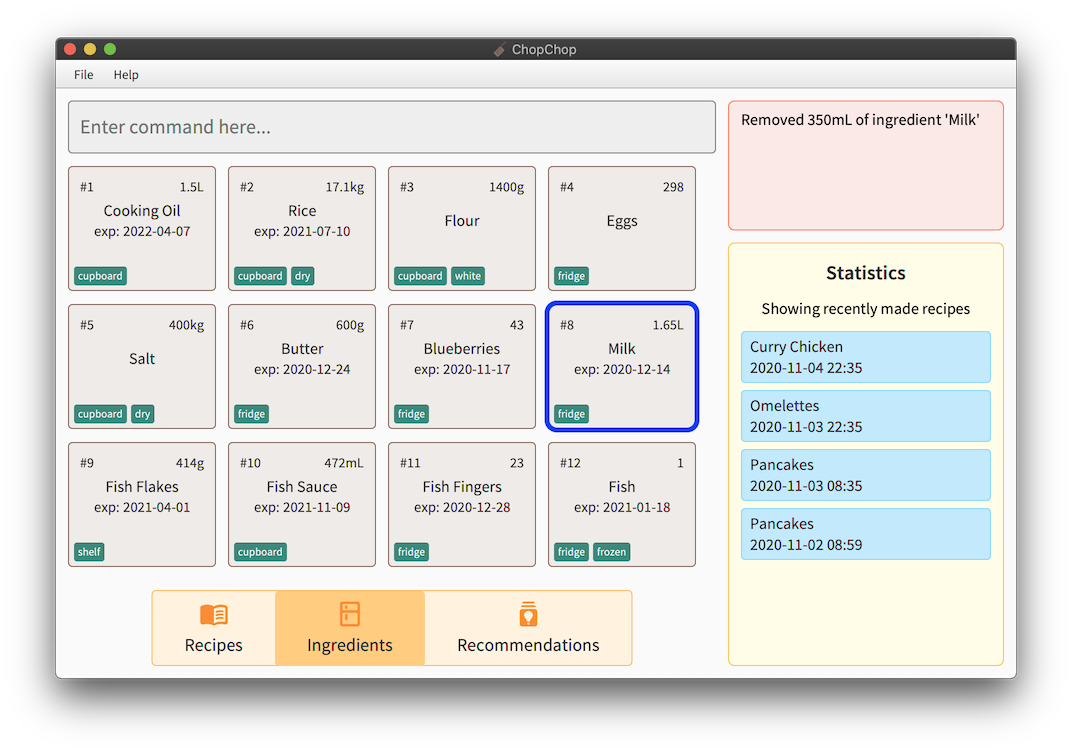
Figure 16.2: You now only have 1.65 litres of milk left
5.5.4 Finding Ingredients — findingredient
This command finds all ingredients containing the given keywords in the name, and it works identically to the find recipe command above.
Constraints:
- At least one search keyword must be given
Usage: find ingredient <keyword> [<keyword>]...
For example, suppose you wanted to find all ingredients containing fish (not in the literal sense, but only in their name):

Figure 17.1: The complete ingredient list
Now, only the matching ingredients are shown:
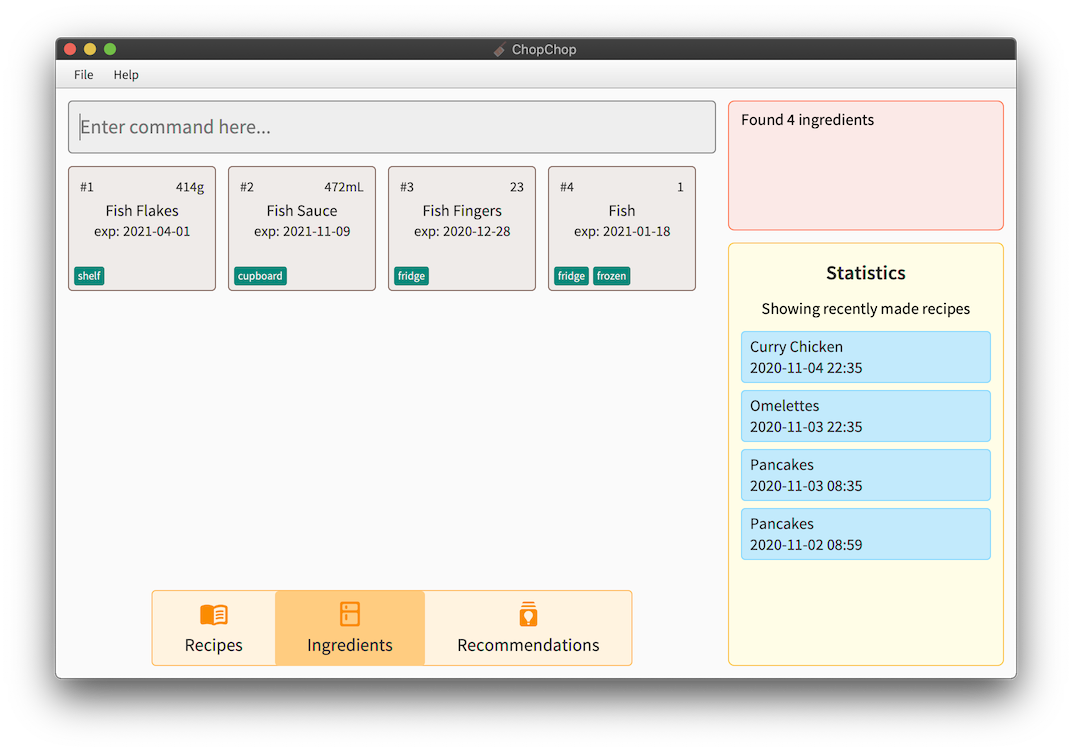
Figure 17.2: Only ingredients containing 'fish' in their name are shown
To clear the search filter, you can either click the Ingredients button, or use list ingredients to return to the list of ingredients.
5.5.5 Filtering Ingredients — filteringredient
This command filters all ingredients and lists those matching the name keywords, tags, and expiry dates specified in the command. Except for the changes in the search fields, this feature works identically to the filter recipe command above. Notably, all the search terms have to match an ingredient before it is found.
Usage:
filter ingredient
[/name <name-keywords>...]...
[/tag <tag-keywords>...]...
[/expiry <expiry-date>]
- Keywords following
/tagand/namedo not have to be complete to match the tag or the ingredient’s name. -
/expiry <expiry-date>filters the ingredients and only lists those that expire before the date provided. - When there are multiple expiry dates specified, only the earliest one will be considered.
Constraints:
- At least one search term must be given, and they should be either
/name,/expiryor/tag. - Search terms must not be empty.
Examples:
-
filter ingredient /name dark chocolate
This matches dark chocolate and dark chocolate syrup, assuming they are the only ingredients whose names contain dark chocolate. -
filter ingredient /name dark chocolate /name syrup
This matches dark chocolate syrup, assuming it is the only ingredient whose name contains both dark chocolate and syrup. -
filter ingredient /tag bitter taste
This matches bitter melon and dark chocolate, assuming they are the only ingredients tagged with bitter taste. -
filter ingredient /tag frequently used /tag sweet
This matches sugar, if it is the only ingredient tagged both frequently used and sweet. -
filter ingredient /expiry 2020-12-01 /expiry 2020-10-31 /expiry 2023-01-01
This matches apple, if it is the only ingredient expiring before 2020-10-31. Note that only the earliest date is considered here (in this case, 31st October 2020), and the rest are ignored. -
filter ingredient /tag powdery /expiry 2020-12-31 /tag bakery /name soda
This matches baking soda, assuming it is the only ingredient that matches all the specified criteria.
To illustrate, suppose you want to search for ingredients tagged both bakery and sweet, expiring before 2021-12-31 and containing sugar in the name; you can use filter ingredient /tag bakery /expiry 2021-12-31 /tag sweet /name sugar:
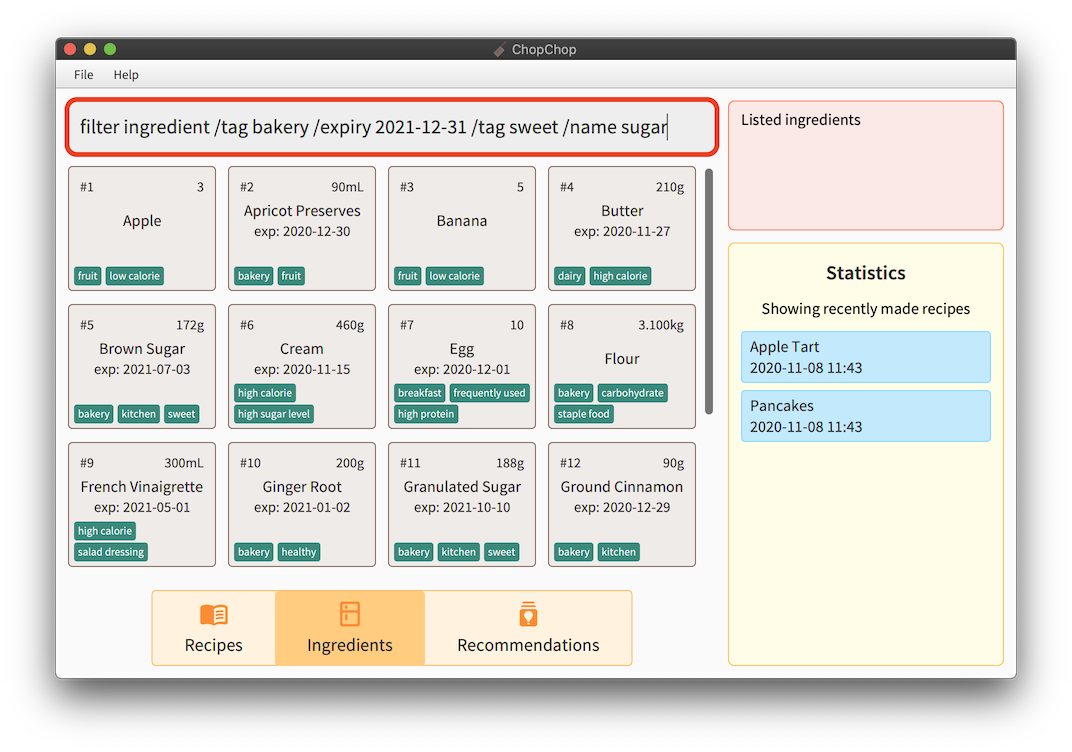
Figure 18.1: The initial list of ingredients
After executing the command, similar to the effect of filter recipe command, the ingredient list has changed, showing the only matching ingredients, Brown Sugar and Granulated Sugar:
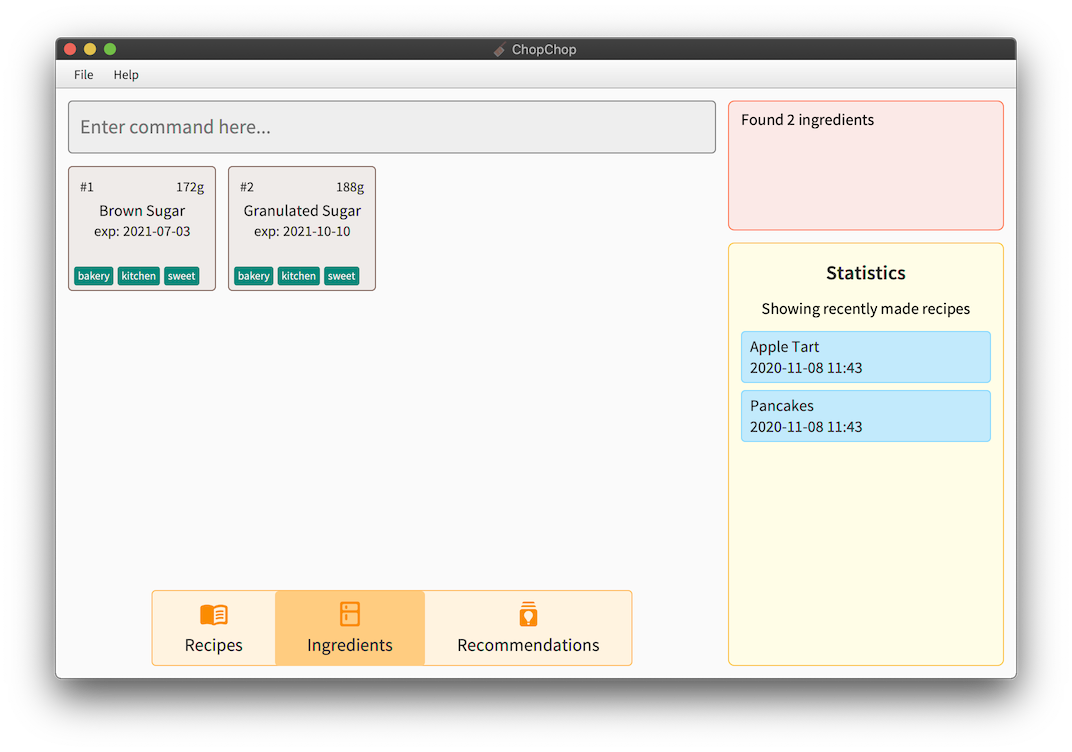
Figure 18.2: The ingredients matching all the provided criteria
Note that Honey, which was also tagged bakery and sweet and would expire before 2021-12-31, was not included because its name does not contain sugar.
To reset the search filter or go back to the full ingredient view, you can click the Ingredients button or run the list ingredients command.
5.5.6 Editing Ingredients — editingredient
This command edits the given ingredient, in a similar fashion to the edit recipe command. However, currently its functionality is limited to only editing the tags of an ingredient (more features coming soon!).
Do refer to the documention on the edit recipe command above to find out how edit-descriptors work; this command currently only supports /tag:add and /tag:delete.
It is an error to delete a tag from an ingredient that did not contain that tag, and similarly to add a duplicate tag to an ingredient.
Usage:
edit ingredient <#REF>
[/tag:<action> <tag-name>]...
Examples:
-
edit ingredient #4 /tag:add frozen
This tags the fourth ingredient currently shown in the ingredient list with frozen. -
edit ingredient sprinkles /tag:delete fridge
This removes the tag fridge from the ingredient named ‘sprinkles’.
5.6 Statistics Commands
Whenever you make a recipe or consume an ingredient, ChopChop makes a record, which you can view with the commands below. The output of these statistics commands are shown in the statistics box on the right side of ChopChop’s interface.
5.6.1 Listing Top Recipes — statsrecipe top
This command shows a list of recipes that were made the most, in descending order (the recipe listed first was made the most number of times).
Note that, even if a recipe was deleted (with delete recipe), its cooking records will still exist in ChopChop. To remove these statistics, you can use stats recipe clear to clear them for all recipes.
Usage: stats recipe top
For example, here is the output for someone who really really loves pancakes:

Figure 19: No pancakes were sacrificed for this picture
5.6.2 Listing Recent Recipes — statsrecipe recent
This command shows a list of the 10 most recently-made recipes, with the most recent one at the top of the list. As with the other statistics commands, deleting a recipe from ChopChop does not delete it from this list.
Note that this is also the view that is displayed by default when no statistics commands have been used yet.
Usage: stats recipe recent

Figure 20: The recently-made recipes view
5.6.3 Listing Recipes within a Time Frame — statsrecipe made
This command shows a list of recipes that were made within the given time frame, arranged in descending chronological order. You can specify the lower bound (earliest date/time), upper bound (latest date/time), both, or neither.
Usage: stats recipe made [/before <date-time>] [/after <date-time>]
The format of <date-time> is as such: yyyy-mm-dd [hh:mm], where yyyy-mm-dd is the familiar date format, and hh:mm is the optional time in 24-hour format (eg. 18:30 for 6.30pm).
If the time component is omitted, it is assumed to be midnight of the given day. If both /before and /after are omitted, then ChopChop shows recipes made on the current day, ie. from midnight to 23:59.
Examples:
-
stats recipe made
This shows all recipes made since the beginning of the current day -
stats recipe made /after 2020-04-15
This shows all recipes made after the 15th of April, 2020 -
stats recipe made /before 2020-12-25
This shows all recipes made before the 25th of December, 2020 -
stats recipe made /after 2020-04-15 /before 2020-12-25
This shows all recipes made between the 15th of April and 25th of December -
stats recipe made /after 2020-01-01 08:00 /before 2020-01-01 23:00
This shows all recipes made between 8am and 11pm on the 1st of January
For example, stats recipe made /after 2020-11-02 /before 2020-11-04 23:00 shows this output:
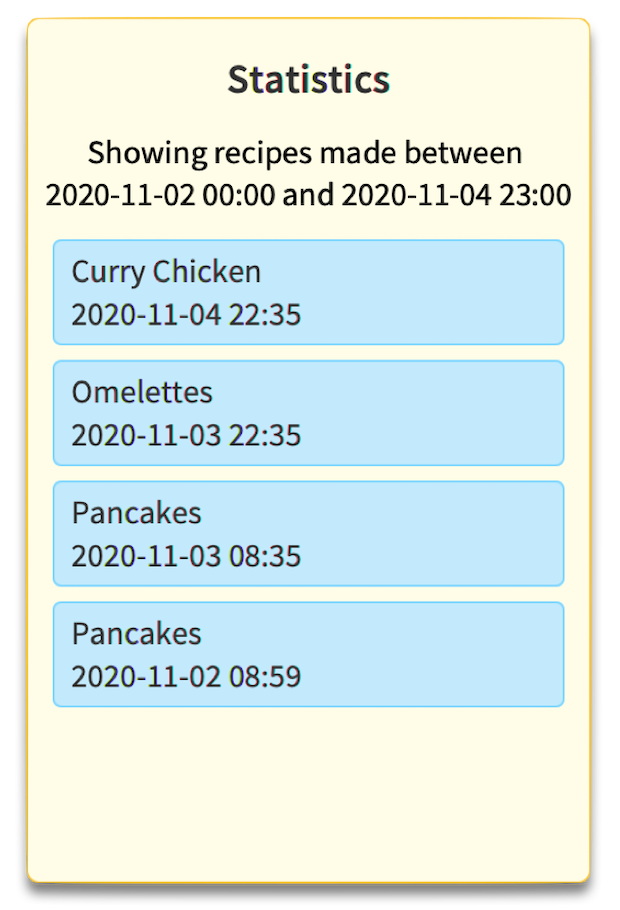
Figure 21.1: Showing the recipes made between a date range
Meanwhile, just executing stats recipe made only shows the recipes made on the current day:
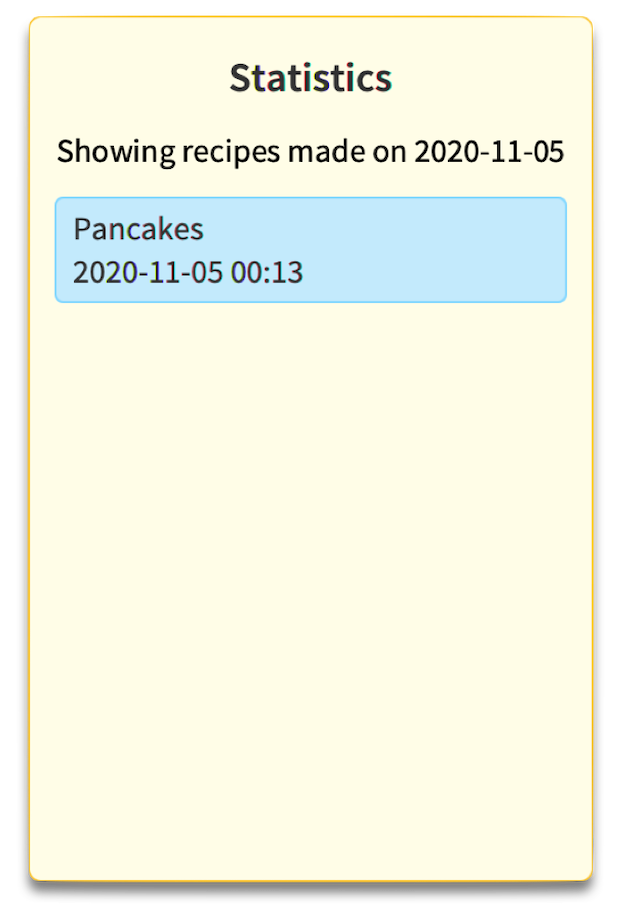
Figure 21.2: Showing the recipes made on the current day
5.6.4 Clearing Recipe History — statsrecipe clear
This command clears the history of the recipes that you’ve made from ChopChop. If you did this accidentally, don’t worry, because you can undo this.
Usage: stats recipe clear
5.6.5 Listing Recent Ingredients — statsingredient recent
This command shows a list of the 10 most recently-used ingredients consumed by make-ing recipes. It is similar to the stats recipe recent command as discussed above, except it deals with ingredients.
Usage: stats ingredient recent
For example, after having just made Scrambled Eggs, these will be the recently-used ingredients:
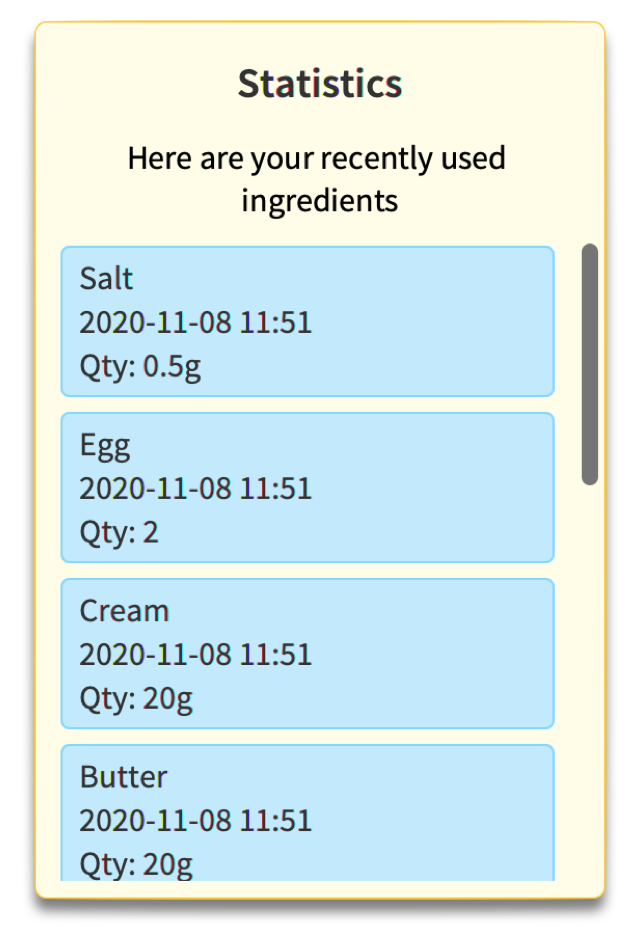
Figure 22: The recently used ingredients view
5.6.6 Listing Ingredients within a Time Frame — statsingredient used
This command shows a list of ingredients that were used within the given time frame, arranged in descending chronological order. You can specify the lower bound (earliest date/time), upper bound (latest date/time), both, or neither.
This command behaves similarly to stats recipe made as discussed above, except that made is replaced with used instead. Otherwise, the arguments (/before, /after) function identically.
Usage: stats ingredient used
5.6.7 Clearing Ingredient History — statsingredient clear
This command clears the history of the ingredients that you’ve used in ChopChop. If you did this accidentally, don’t worry, because you can undo this.
Usage: stats ingredient clear
5.7 Command Summary
For easy reference, here are the commands that ChopChop supports, listed in alphabetical order. You can click on the name of the command to go to its section in the User Guide.
| Command | Description | Syntax Summary | Undo |
|---|---|---|---|
| add ingredient | Adds a new ingredient, or increases the quantity of an existing ingredient | add ingredient <name> [/qty <quantity>] [/expiry <expiry-date>] [/tag <tag-name>]... |
✔ |
| add recipe | Adds a new recipe |
add recipe <name>
[/ingredient <name>
[/qty <quantity>]]...
[/step <step>]...
[/tag <tag-name>]...
|
✔ |
| delete ingredient | Completely deletes an ingredient, or removes some quantity of it | delete ingredient <#REF> [/qty <quantity>] |
✔ |
| delete recipe | Completely deletes a recipe | delete recipe <#REF> |
✔ |
| edit ingredient | Edits an existing ingredient |
edit ingredient <#REF>
[/tag:<action>
<tag-name>]...
|
✔ |
| edit recipe | Edits an existing recipe |
edit recipe <#REF>
[/name <new-recipe-name>]
[/ingredient:<action>
<ingredient-name>
[/qty <quantity>]
]...
[/step:<action>[:<index>]
<step>]...
[/tag:<action>
<tag-name>]...
|
✔ |
| filter ingredient | Searches for ingredients by one or more filtering criteria | filter ingredient [/name <name-keywords>...]... [/expiry <expiry-date>] [/tag <tag-keywords>...]... |
✘ |
| filter recipe | Searches for recipes by one or more filtering criteria |
filter recipe
[/name <name-keywords>...]...
[/tag <tag-keywords>...]...
[/ingredient
<ingr-keywords>...]...
|
✘ |
| find ingredient | Searches for ingredients by their name | find ingredient <keyword> [<keyword>]... |
✘ |
| find recipe | Searches for recipes by their name | find recipe <keyword> [<keyword>]... |
✘ |
| help | Shows help in general, or help for specific commands | help [<command-name> [<command-target>]] |
✘ |
| list ingredient | Shows the main ingredient list, and clears any search filters | list ingredients |
✘ |
| list recipe | Shows the main recipe list, and clears any search filters | list recipes |
✘ |
| make recipe | Makes a recipe, consuming ingredients and recording statistics | make recipe <#REF> |
✔ |
| quit | Exits ChopChop | quit |
✘ |
| redo | Redoes a command that was previously undone | redo |
✘ |
| stats recipe clear | Clear cooked recipe history | stats recipe clear |
✔ |
| stats recipe made | Shows recipes made within a given time frame | stats recipe made [/after <date-time>] [/before <date-time>] |
✘ |
| stats recipe recent | Shows recently made recipes | stats recipe recent |
✘ |
| stats recipe top | Shows the top recipes | stats recipe top |
✘ |
| stats ingredient clear | Clear ingredient usage history | stats ingredient clear |
✔ |
| stats ingredient recent | Shows recently used ingredients | stats ingredient recent |
✘ |
| stats ingredient used | Shows ingredients used within a given time frame | stats ingredient used [/after <date-time>] [/before <date-time>] |
✘ |
| undo | Undoes a command that was previously executed | undo |
✘ |
| view | Opens the detailed view for a recipe | view recipe <#REF> |
✘ |
6 Quantities and Units
In order to keep track of ingredients correctly, ChopChop needs to know about their amounts. Currently, there are 3 ‘kinds’ of units supported; volume, mass (weight), and counts. Specifically, these are the supported units:
-
ml,mL— millilitres -
l,L— litres (1000 ml) -
cup,cups— metric cup (250 ml) -
tsp— metric teaspoon (5 ml) -
tbsp— metric tablespoon (15 ml) -
g— gram -
mg— milligram (0.001 g) -
kg— kilogram (1000 g)
Quantities without a unit are assumed to be dimensionless ‘counts’; for example, 3 eggs. They do not need to be whole numbers, so that a recipe can use 2.5 apples, for example.
6.1 Ingredient Combining
As mentioned above, ChopChop will combine ingredients when you add them, provided they have compatible units. Combining works as you would expect, and is rather flexible; adding 3 cups of milk to an existing stock of 400ml will yield 1.15l.
However you cannot, for example, add 300g of blueberries to 4 blueberries, as grams and counts are incompatible units.
7 Frequently Asked Questions
Here are some frequently asked questions about ChopChop:
Q: How do I save my changes?
A: ChopChop saves your changes automatically whenever a change is made, so you do not need to worry about doing it manually.
Q: How do I transfer my data to another computer?
A: Simply copy the folder named data that you will find next to chopchop.jar to the new computer, and all your recipes and ingredients will be copied over as well.
Q: How can I rename an ingredient?
A: Currently, ingredients cannot be renamed.
Q: Why is ChopChop telling me that there are incompatible ingredients?
A: Due to the way quantities are handled, recipes need to use the same kind of unit as the ingredient you have in storage. For example, if Butter was recorded as mass (in grams), you can only refer to it in recipes using grams/milligrams/kilograms, but not volumes (tablespoons/cups, etc.).
Q: How can I use a unit like oz?
A: Currently custom units are not supported in ChopChop, though they are coming in a future version! We only support metric units for now.
8 Glossary
Here are some terms you might be unfamiliar with in this document, and their associated meanings:
| Word/Phrase | Meaning |
|---|---|
| Case Insensitive | Capitalisation is not considered, eg. aAaAaAaA and aaaaaaaa are the same when comparing case insensitively |
| Command | A series of text you type into the Command Box in order to perform an action in ChopChop |
| GUI | A graphical user interface, which is the visual display that you see in ChopChop |
| Index | A number that you can use to refer to an ingredient or recipe in a command; it appears in the top left corner of items |
| Ingredient | A food item (eg. salt, butter) that you keep in stock; needed to make recipes |
| Recipe | A dish that can be made using some ingredients; has a list steps to make it, and a list of ingredients used |
| Tag | A word or short phrase (eg. sweet, simple recipe) that you can attach to ingredients and recipes to identify them |